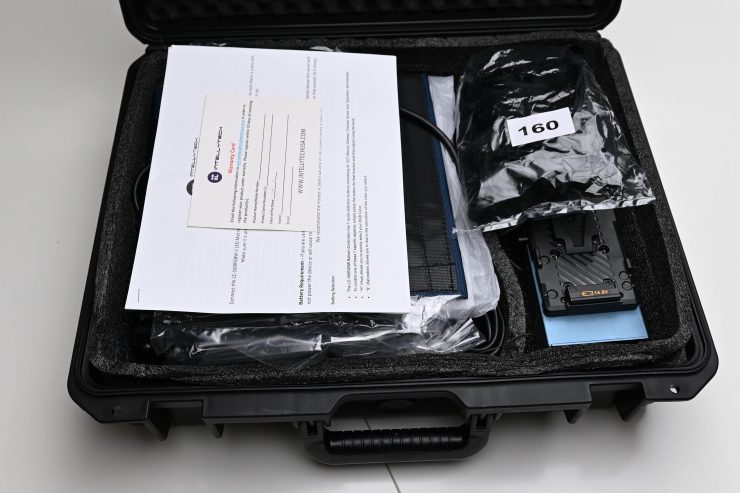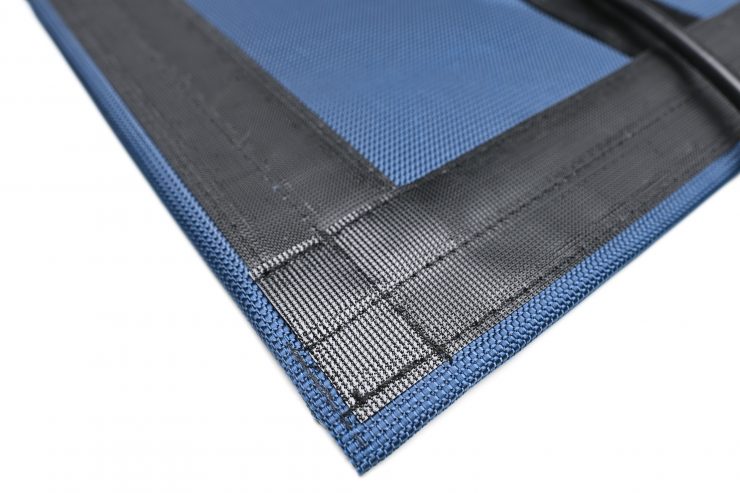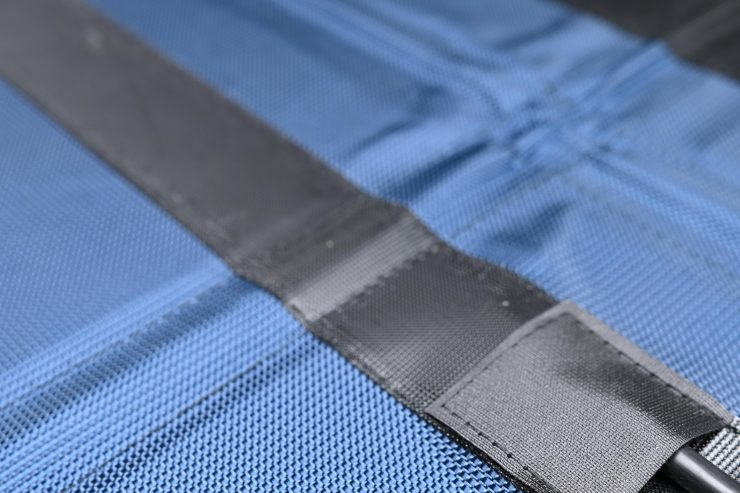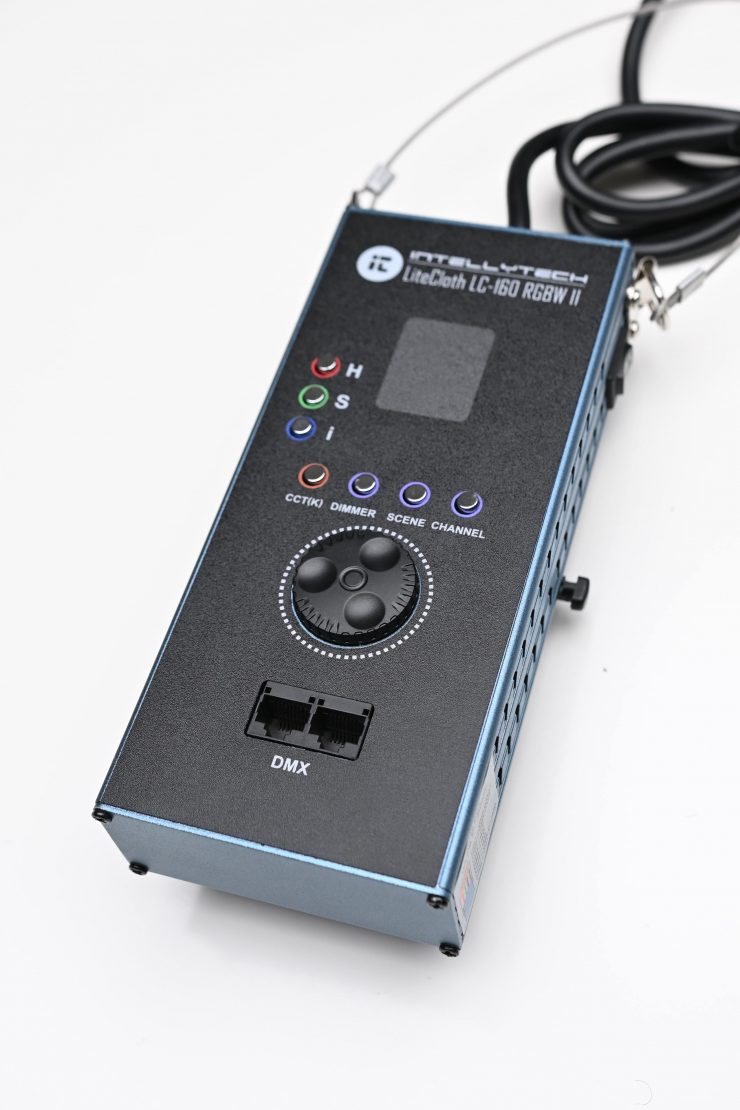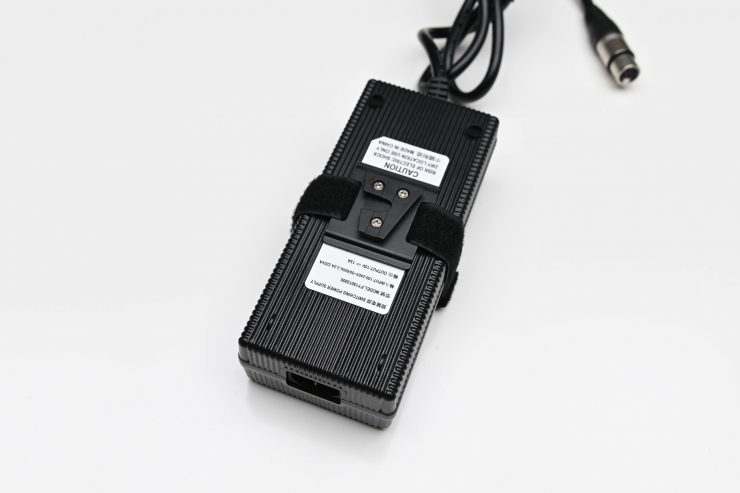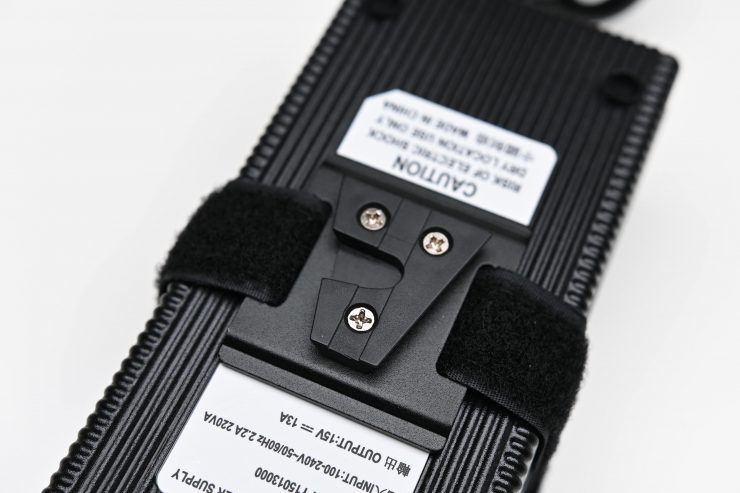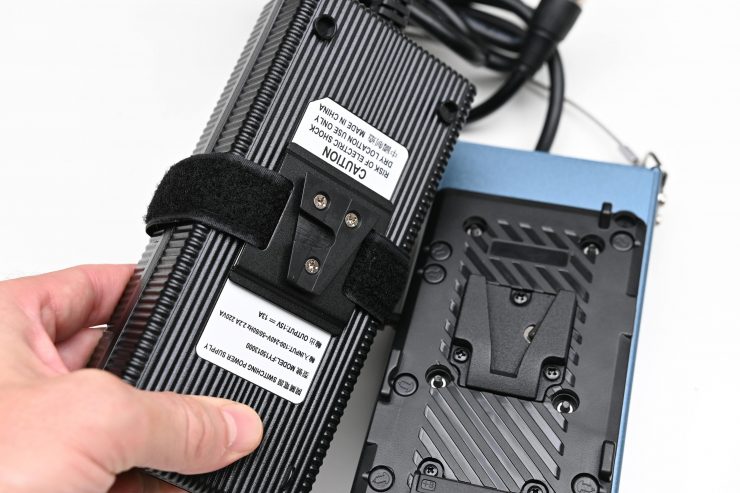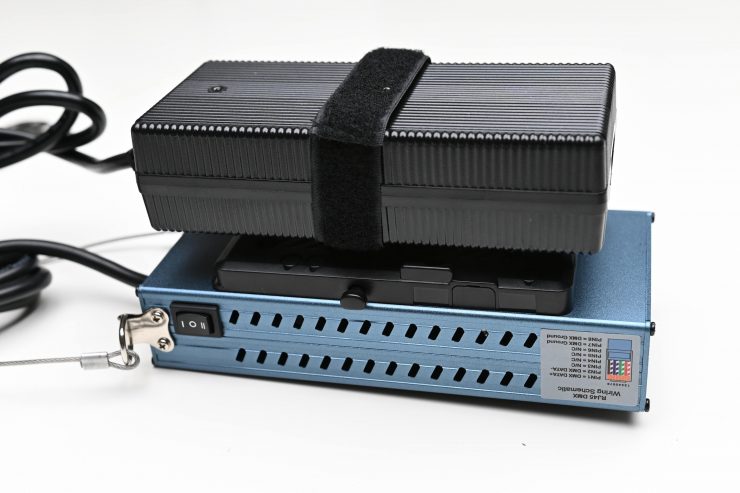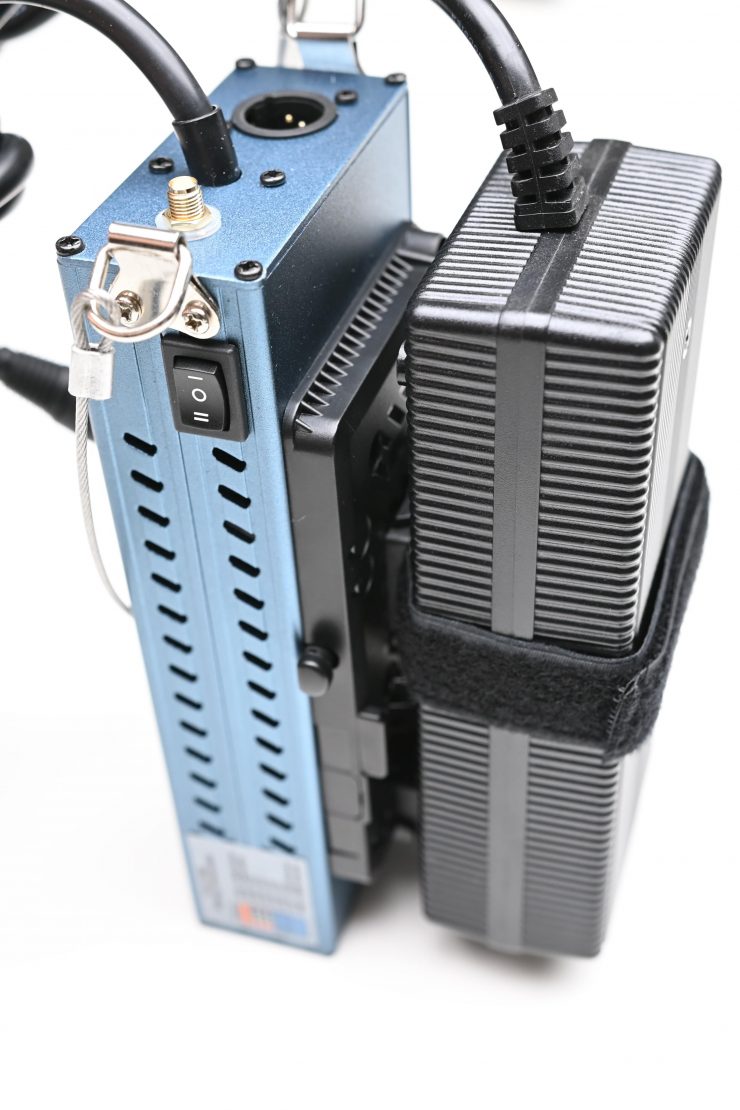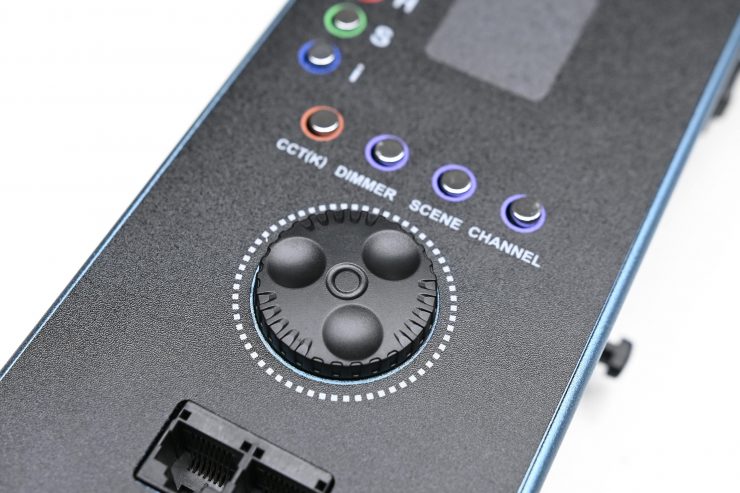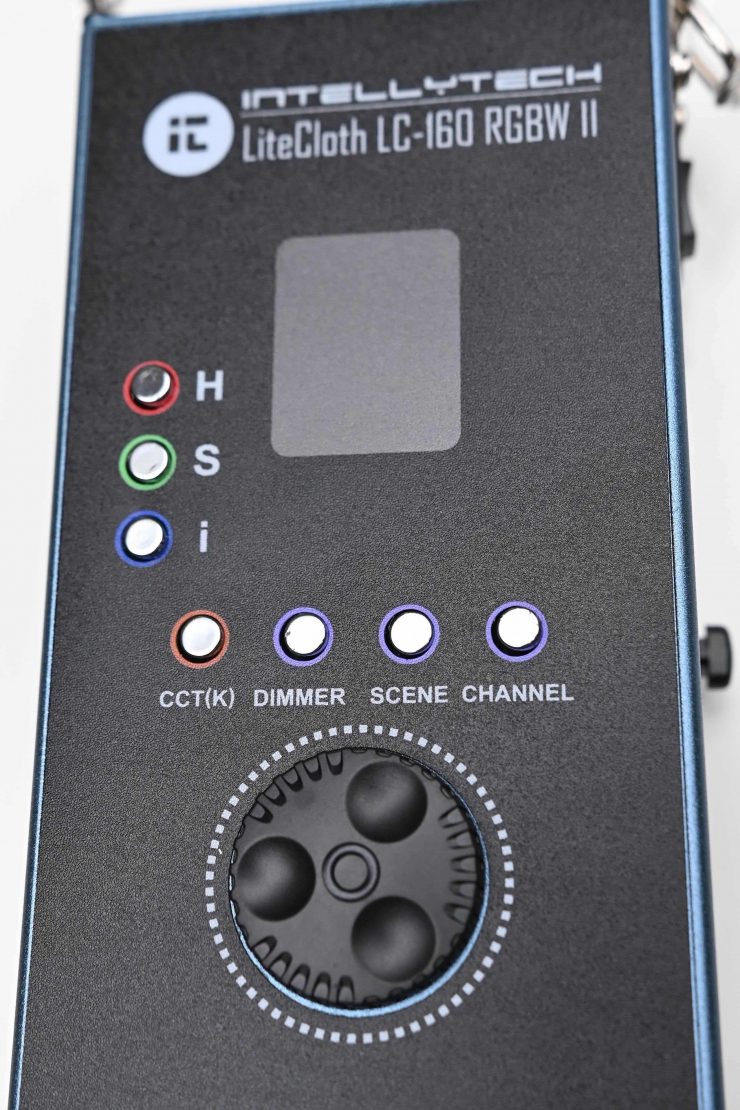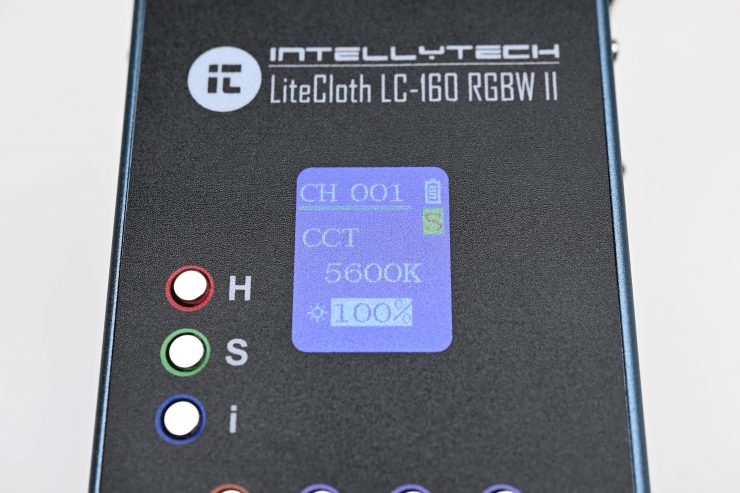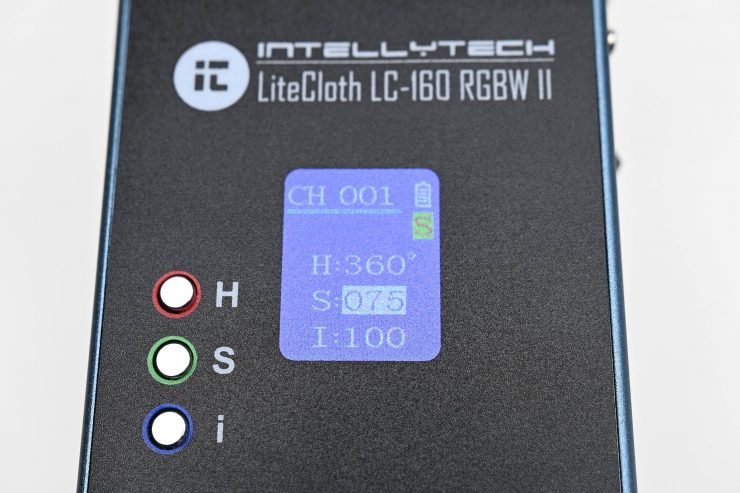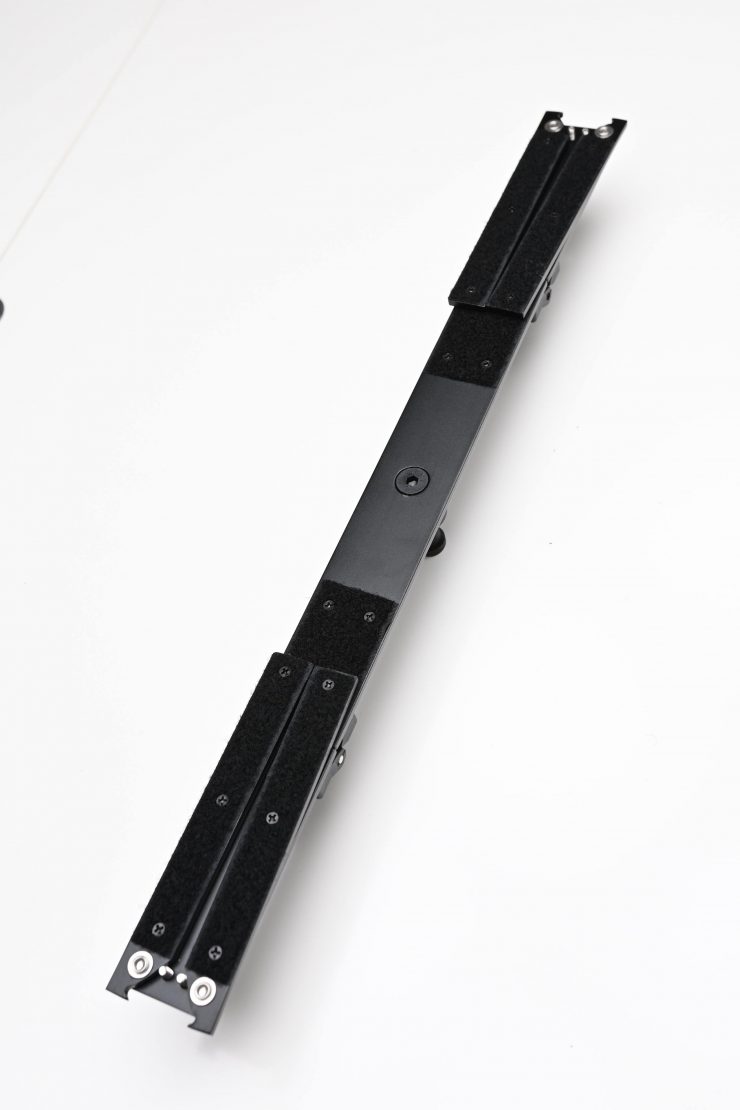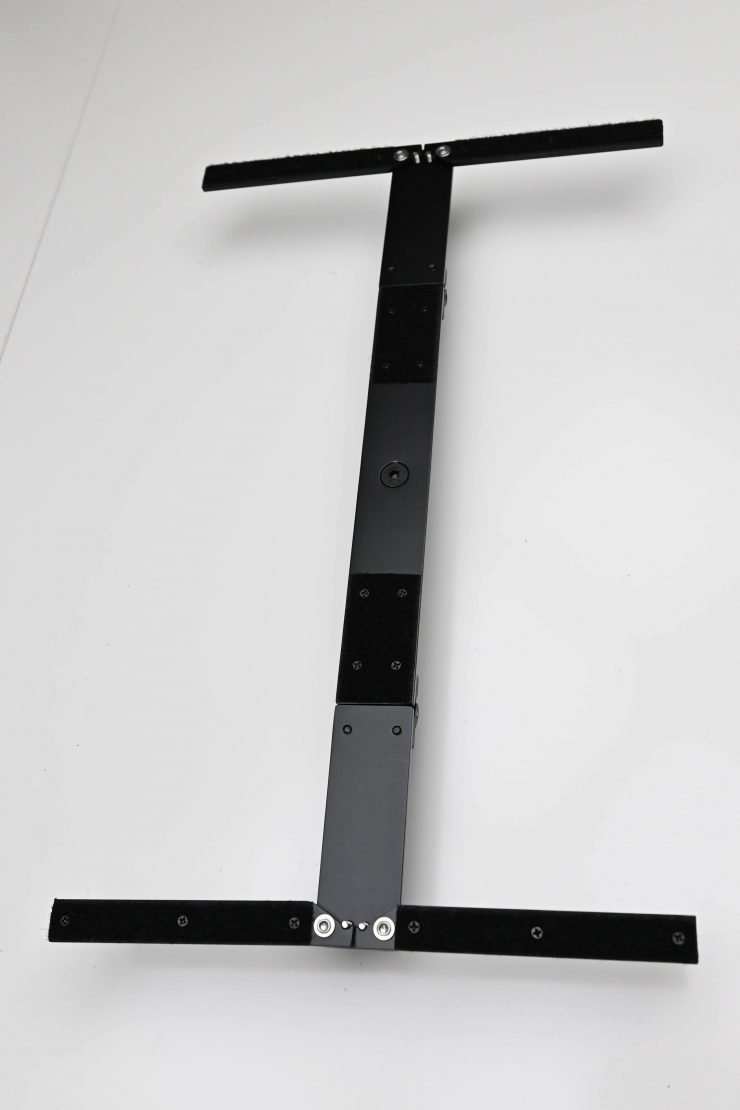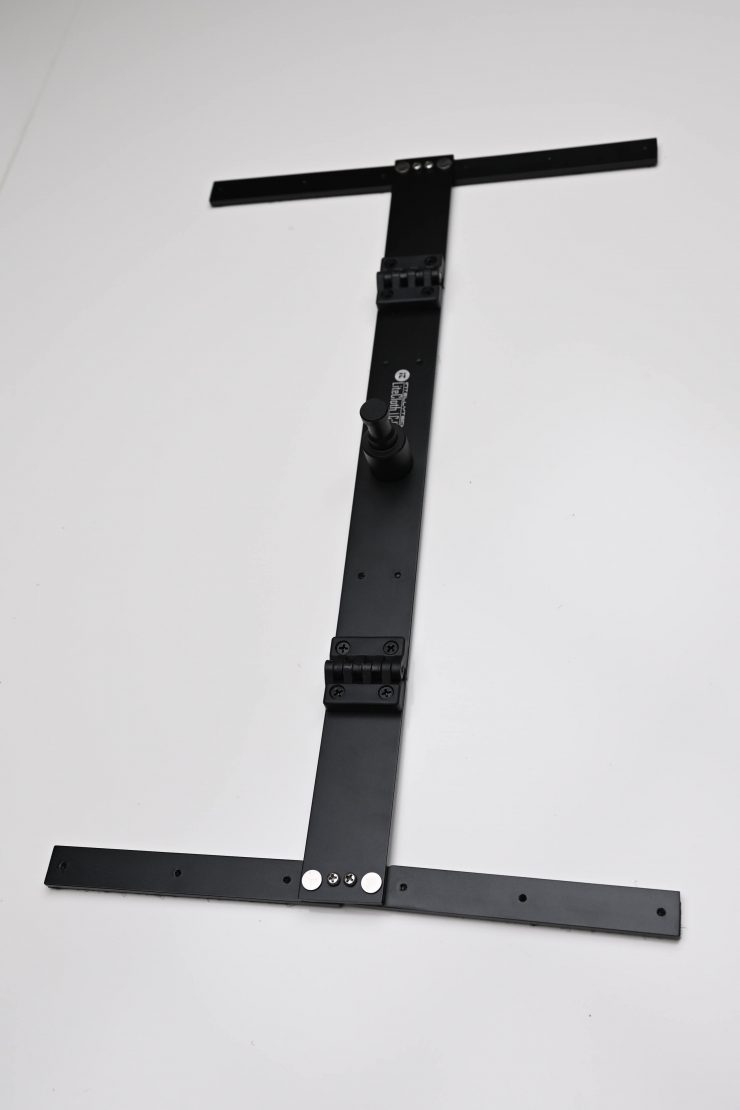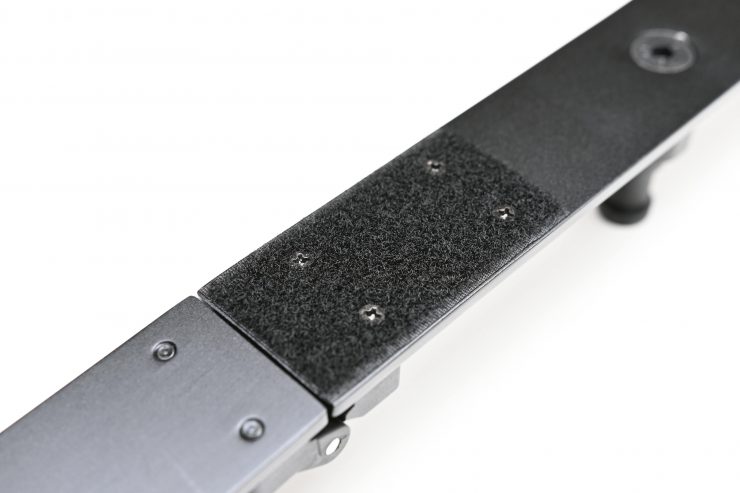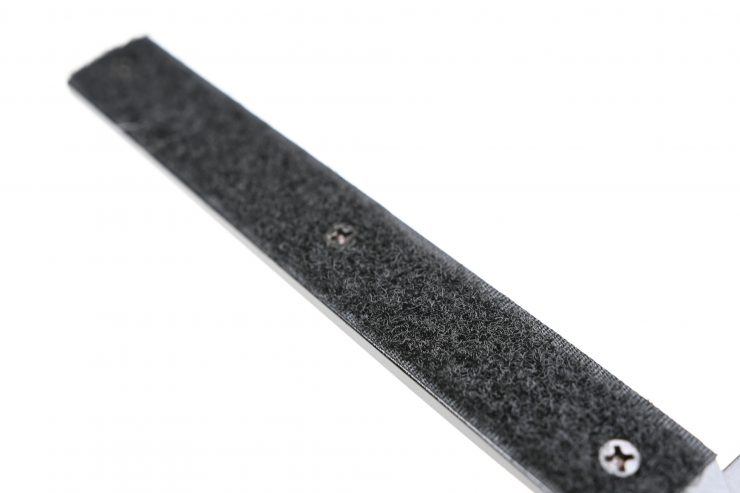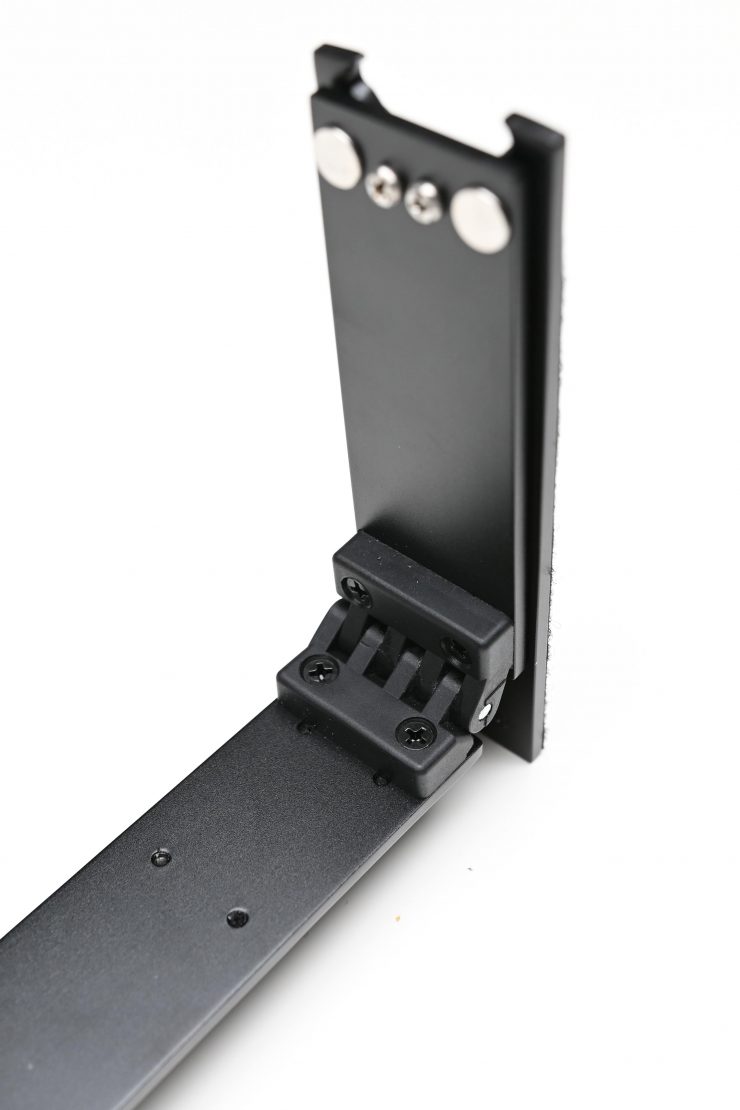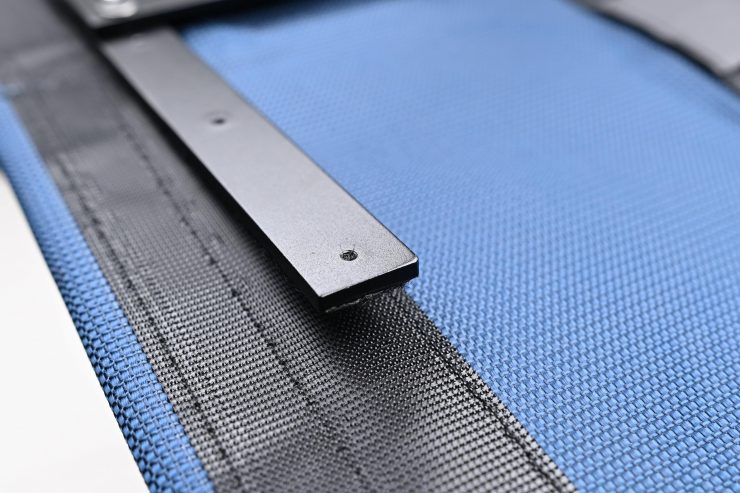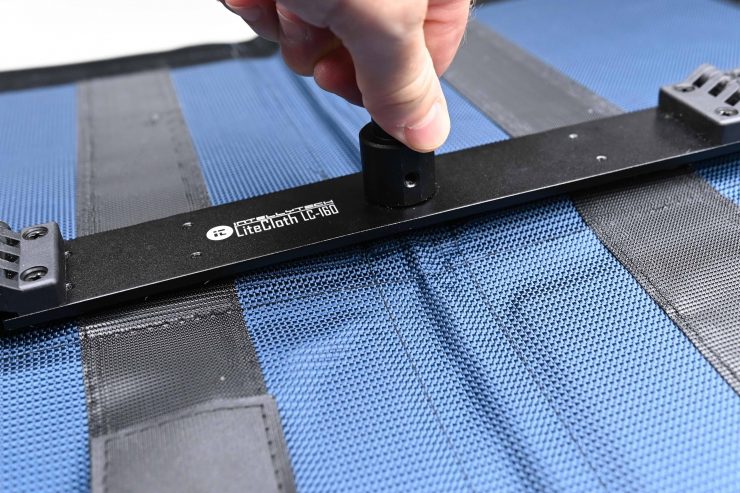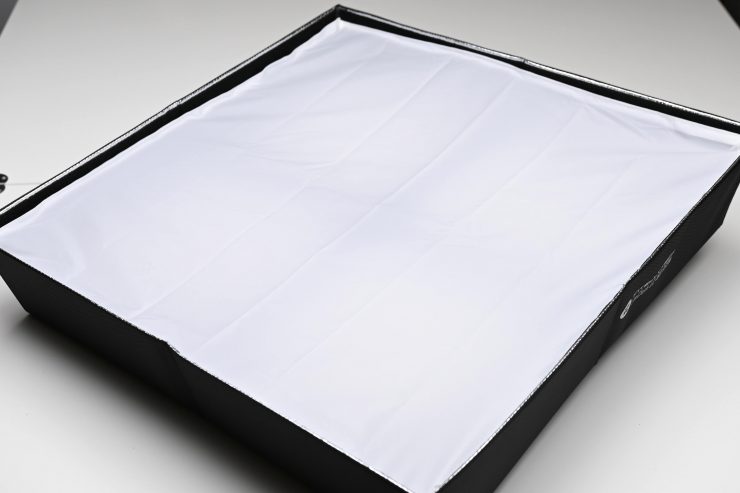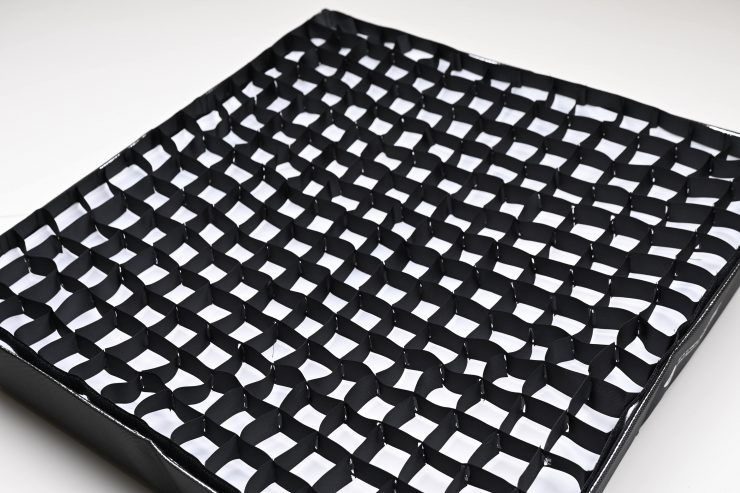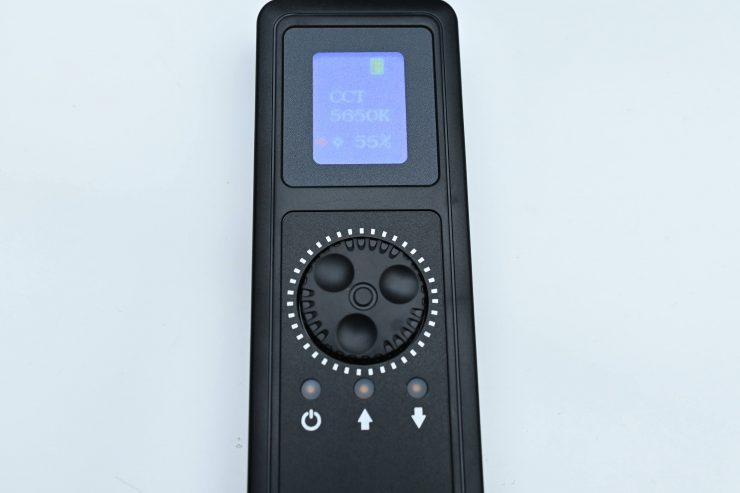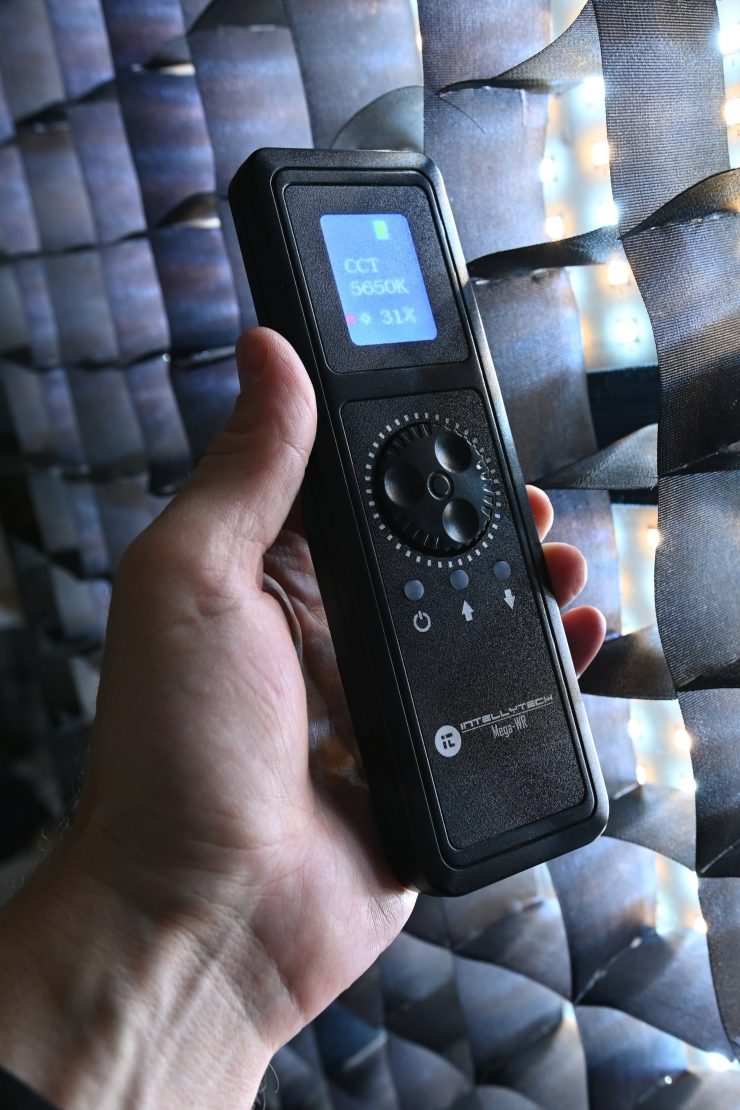
The Intellytech LiteCloth LC-160RGBW II is a 2×2 flexible LED light that has the versatility to be used for a wide range of lighting applications.
The Intellytech LiteCloth LC-160RGBW II is the follow up to the company’s LiteCloth LC-160RGBW, which has now been discontinued.
Erik reviewed the original LiteCloth LC-160 on the site a few years ago. That light wasn’t RGBW, but it was Kelvin color temperature adjustable from 3000K to 10,000K. You can see the review above.
What’s new?
The new LC-160RGBW II adds Hue, Saturation, and Intensity controls (HSI) to increase its versatility. Additionally, it’s claimed to be 15% brighter than the first generation.
The LC-160RGBW II is Kelvin color temperature adjustable from 3,000K-10,000K with a claimed color rendition of 95+ (CRI/TLCI).
The light draws 160W and because of its physical size, it can create a reasonably broad lighting source.
You can power the light via AC or battery. You can choose either a V-Mount or Gold Mount battery plate.
What do you get?
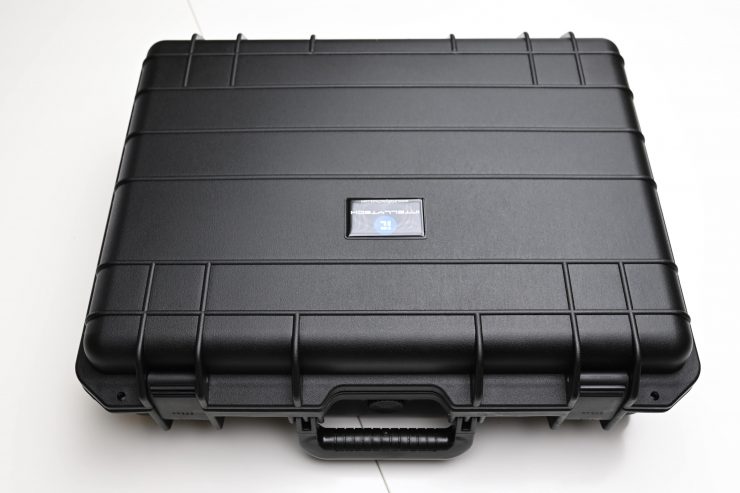
The LC-160RGBW II is sold as a complete kit and it includes a softbox, diffuser, grid, mounting bracket, controller w/ attached battery plate (v-mount or gold mount), AC, and carrying case. The entire kit fits into the hard carrying case measuring in at 18″x 16″ x 4.5″.
It is nice to get an included hard case, especially if you are someone who travels a lot.
Compact & easy to travel with?
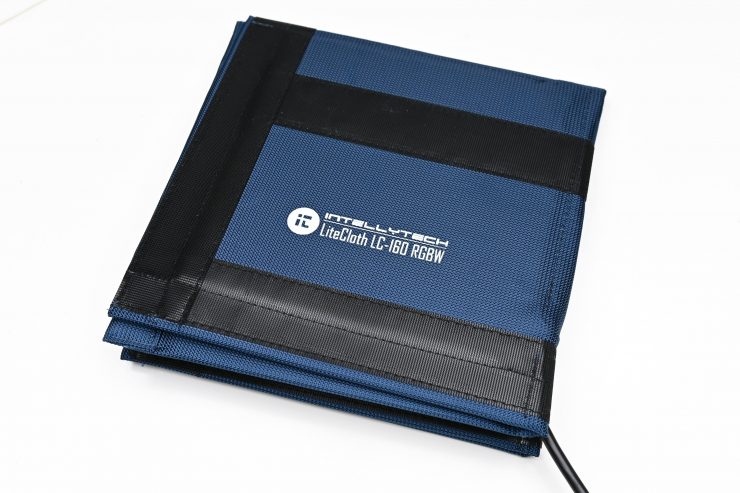

From this….. 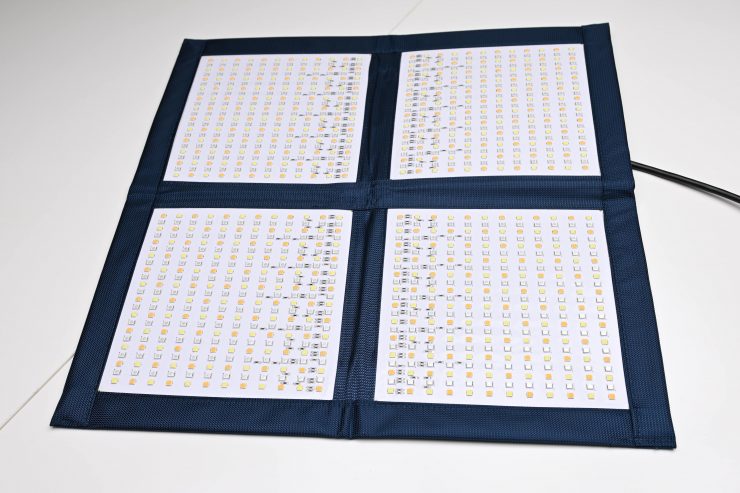
…to this
The LC-160RGBW II is a 22″ x 22″ LED Mat (2’x2′ W/ included softbox) that folds down to a 12″ x 12″ square.
The light is essentially four 1×1 panels that are combined to create a single larger lighting source.
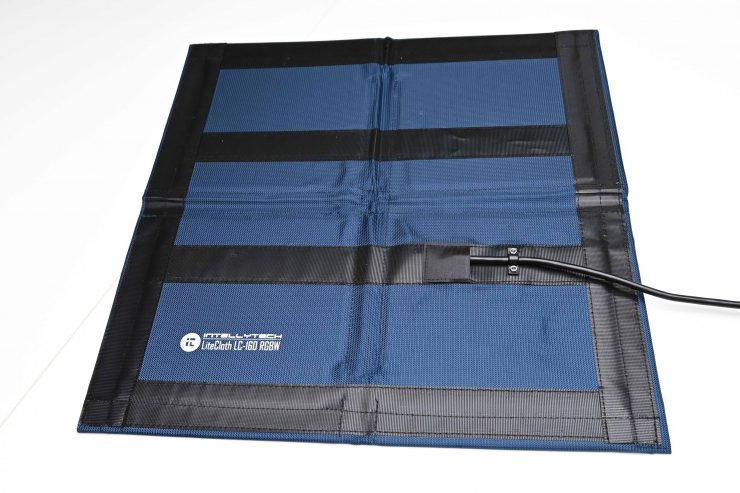
The LC-160RGBW II has a firm backing behind the Mat, but you can fold it down at its collapsible cross-sections. This form factor allows for the light to be set up quickly without the need for a giant metal frame or x-bracket. More on the included frame system later.
The 2′ x 2′ Light Kit takes up less space than a conventional 1′ x 1′ panel but it provides you with a larger lighting source and more flexible placement options.
The ILC-160RGBW II weighs in at 2.3 kg (5.07 lb) with the light, softbox, honeycomb grid, and the mounting bracket.
The included hard case with all of the accessories weighs in at 8.89 kg (19.6 lb). If you wanted to save on weight, you could remove the components from the hard case and put them into another bag.
Power Draw
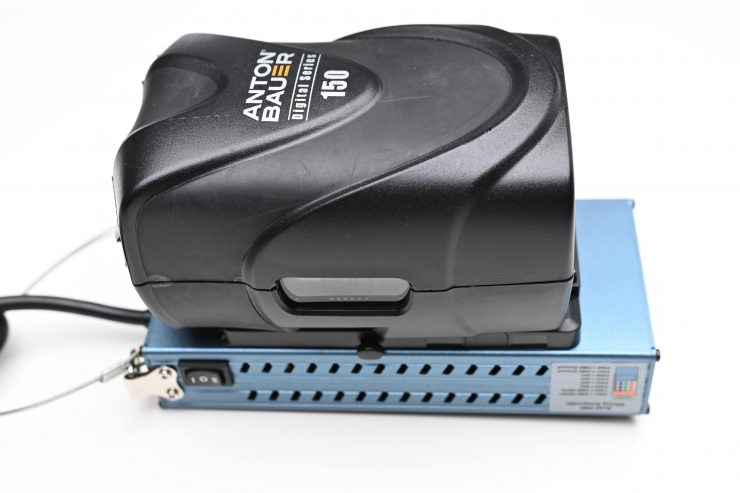
You can power the light via AC or battery. You can choose either a V-Mount or Gold Mount battery plate. The light draws 160W. Having a power draw of 160W means you can run it at 100% output from a flight safe battery. This is important for traveling shooters who need to take lights on location where there may not be any access to mains power.
Controller & Power Supply
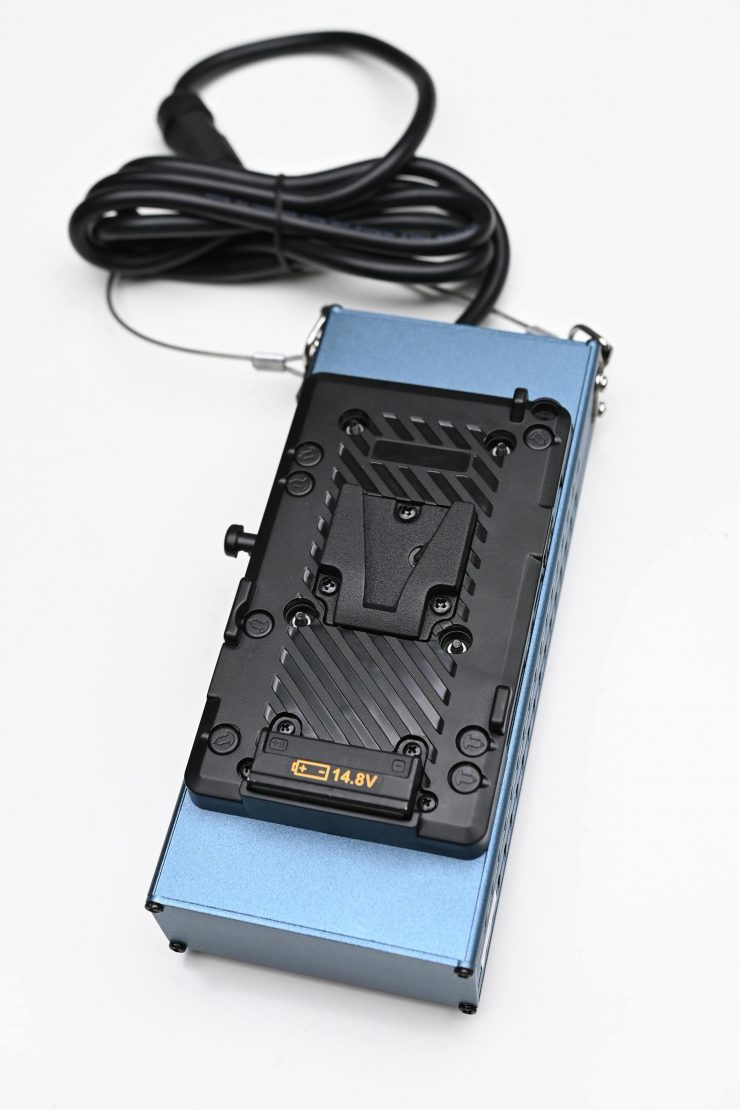
As I just mentioned, the light comes with a controller with a built-in V-Lock or AB Gold Mount battery plate depending on which version you choose.
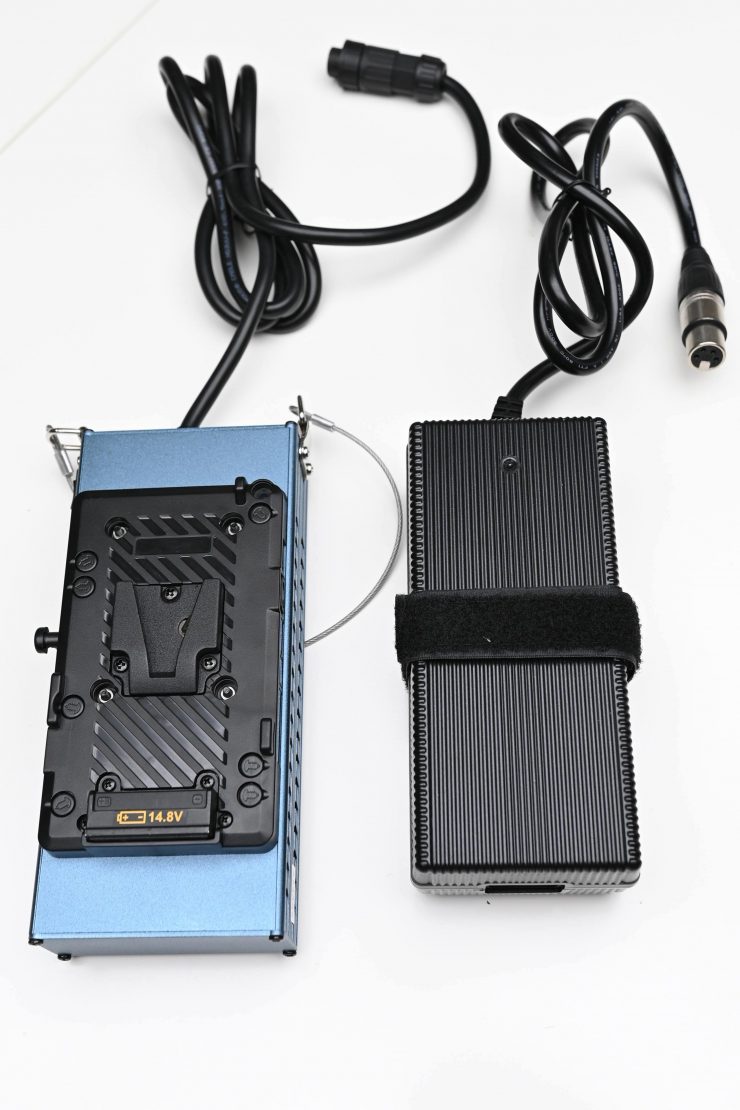
It also has a separate AC power supply that you can attach to the battery plate or have it separate if you choose. The power supply comes with a little V-mount or AB Gold Mount adapter (depending on the version you choose) that is attached via a velcro strap. Personally I would have preferred to have seen it physically attached to the power supply.
Having a separate controller and AC power supply is a catch 22. It is nice if you are running the light off a battery because you can keep everything smaller and more compact. However, if you want to run it off AC power you have to hook up two separate boxes. Would I have preferred to see an all-in-one power supply/controller? Maybe, but then it would have made it a lot larger and heavier.
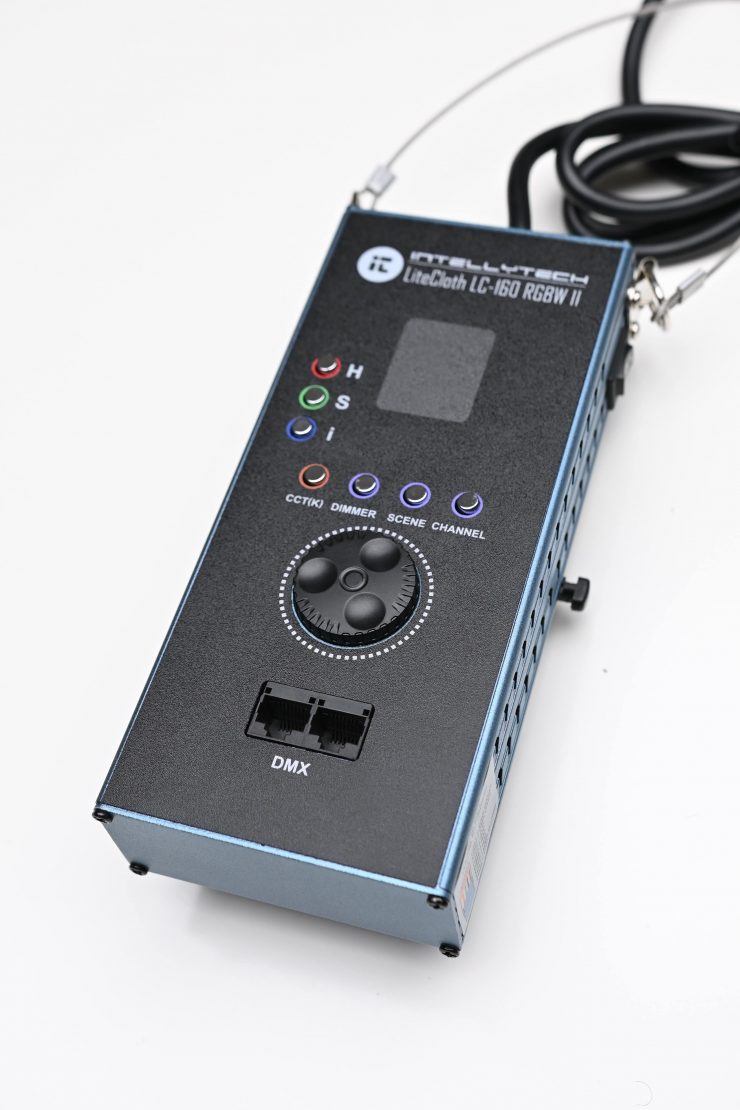
The controller is pretty well made and I think it will be durable enough for most people’s applications. While there is nothing overly special about it, it is clearly laid out which makes it intuitive and straight forward to us.
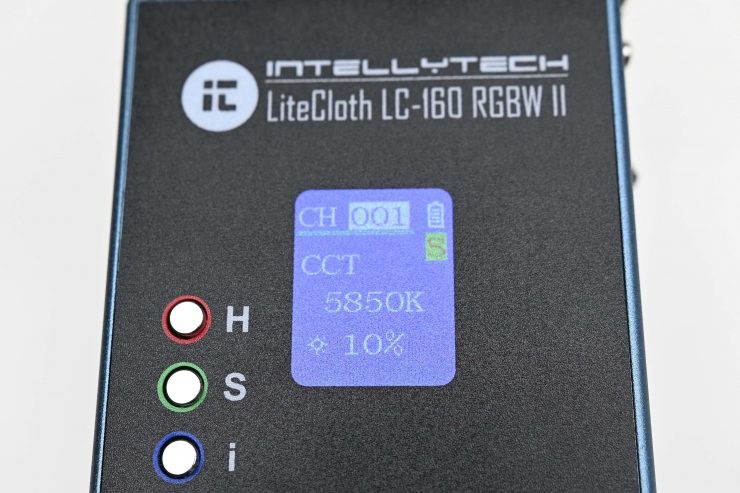
You can make Kelvin color temperature adjustments in blocks of 50K. You can dim the light from 0-100% in 1% increments.
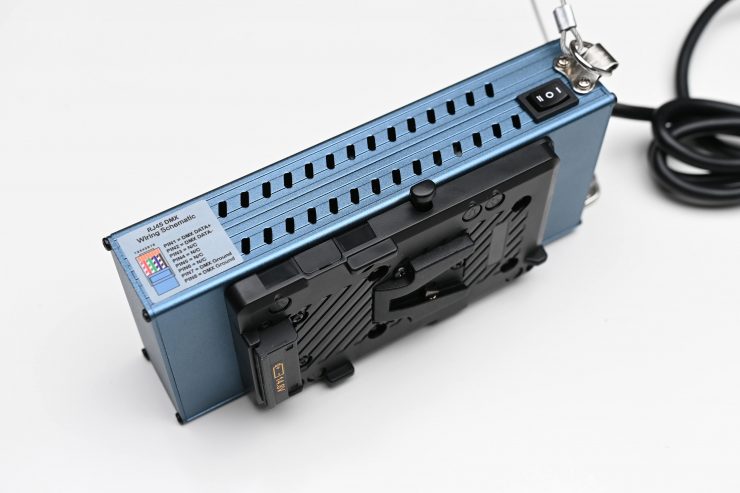
In a nice touch, the controller has built-in circuit protection, so if you try and use it with an incompatible battery it will shut itself off.

The controller’s battery plate also has an additional D-tap outlet on it if you need to power another device.
Flexible and foldable LED mats are great because they are compact and lightweight, but they still require power like any other light. They can’t magically produce a lot of output without a fairly large power supply.
The controller is relatively lightweight (790 g / 27.8 oz) and you can use the included wire lanyard to attach it to a light stand.
The power supply tips the scales at 890 g (31.4 oz).
The light can be set up to a DMX512 board for studio use. Additionally, all units can be controlled via the optional LC-WR Wireless Remote. You can choose to control the fixture individually, or by syncing multiple lights together for simultaneous control.
Mounting
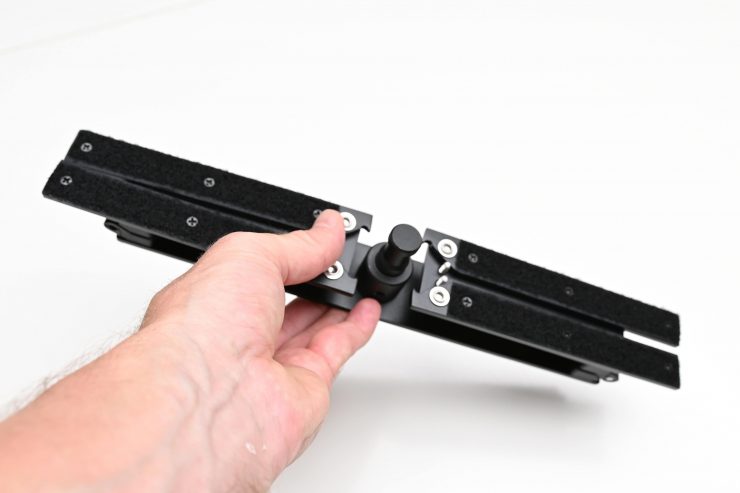
The biggest pain with most flexible LED lights is it comes to mounting. I have seen some pretty bad designs over the years, and there are only a handful of lights that have a half-decent mounting solution.
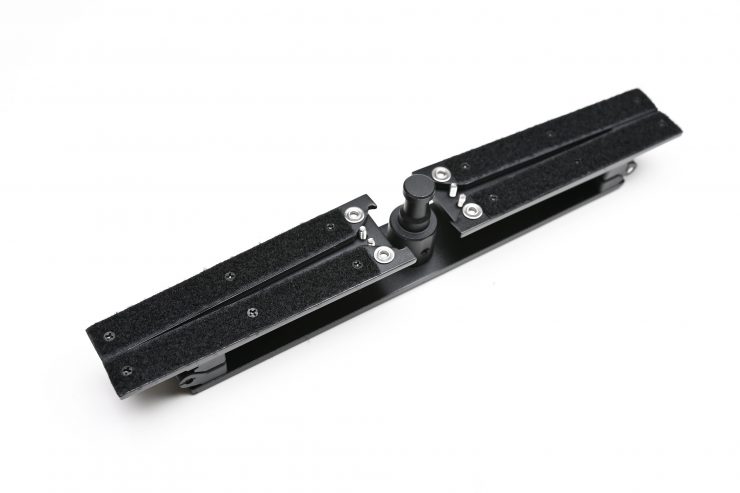
The Intellytech uses a nice robust mounting frame that folds down into a compact size for storage and transport. It opens up and there is velcro on the backside of the arms.
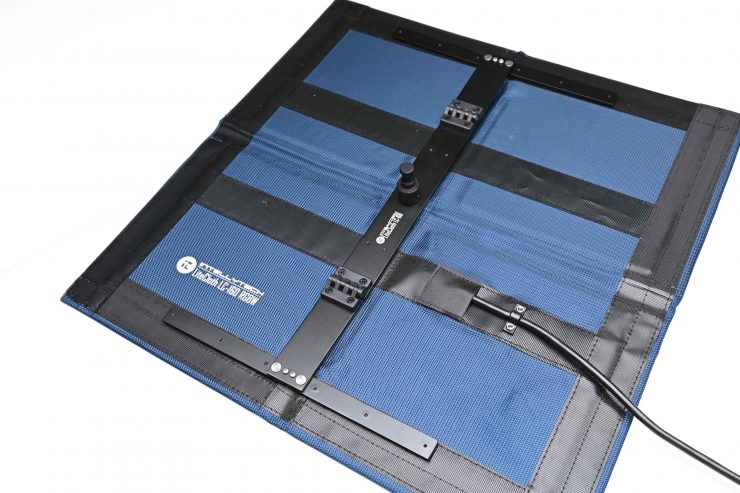
The included mount secures to the rear of the Mat via a special high-strength Velcro.
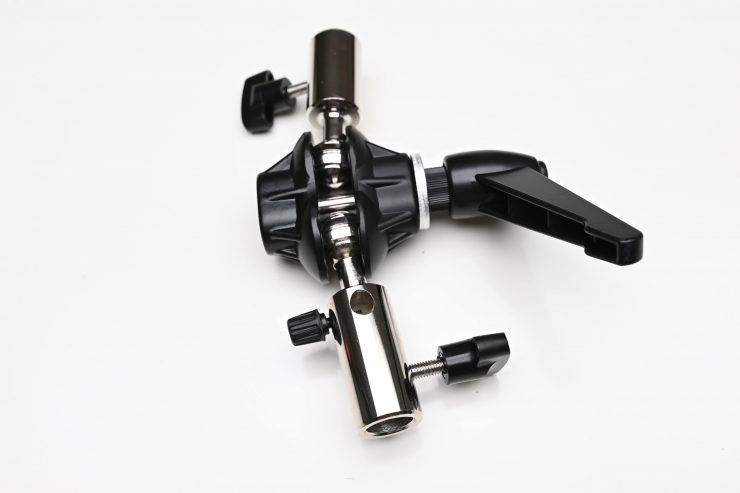
The included mounting bracket is very heavy duty and it does allow you to angle the light in a lot of directions.
Set-Up Time & Usability
The biggest downside of using most flexible or foldable LED lights is that they are a pain to set up. You normally have to construct up frames and mounts and then hook them up to controller units and power supplies.
If you are working by yourself or in a small crew you need to be able to set up lighting quickly. The Intellytech, like most flexible LED lights, does require a few steps to set it up. I do like the design of the mounting bracket because it allows you to fold it down and keep it nice and compact. You also don’t need to construct it like some other lights that are out there.
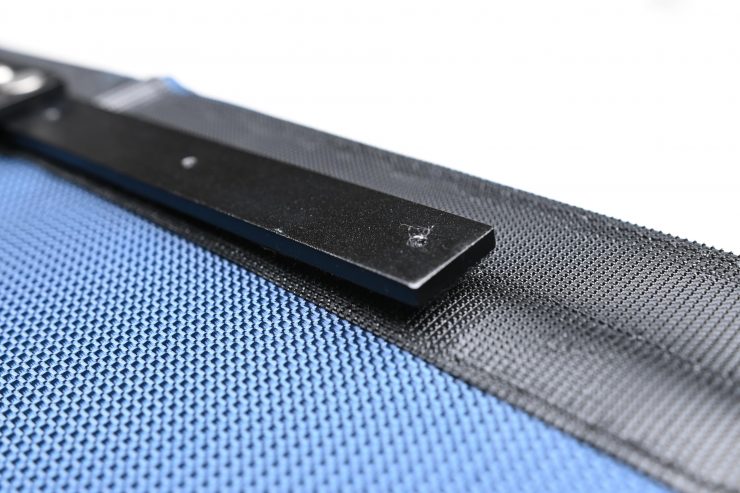
My only concern is that the light is only attached to the bracket via velcro and nothing else. If I lifted it up and held it horizontally from the frame, it starts to come off the velcro is places. I would be reluctant to mount it directly overhead people. Even though there is probably not much chance of it coming completely off, I would rather be cautious than sorry.
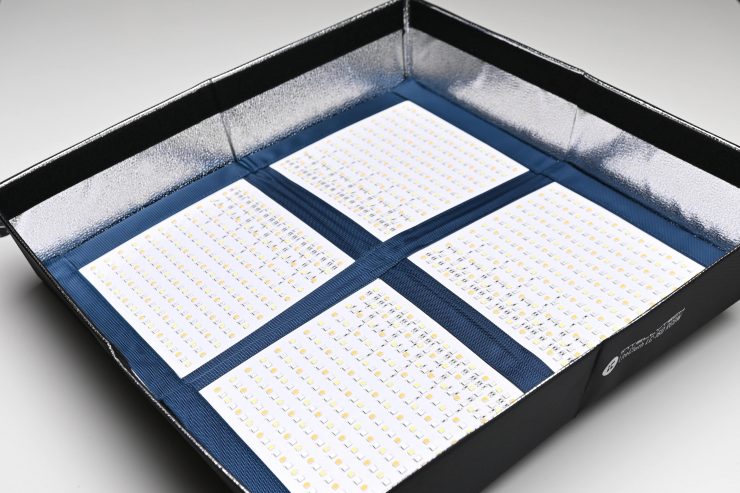
The softbox frame, diffuser, and honeycomb grid are all pretty straightforward to attach. What you do need to bear in mind is that it is probably going to take you around 5-7 minutes to set up everything from scratch.
As the Intellytech is quite lightweight, you could attach it to a wall or a ceiling with some tape if need be. While this may not be the best option for obvious reasons, it can still be done. In the past on assignments in countries like India I have often gaffer taped flexible lights to walls to hide them from view.
The great aspect of flexible lights is your ability to shape them and manipulate them to create unique light sources.
Built-In Effects
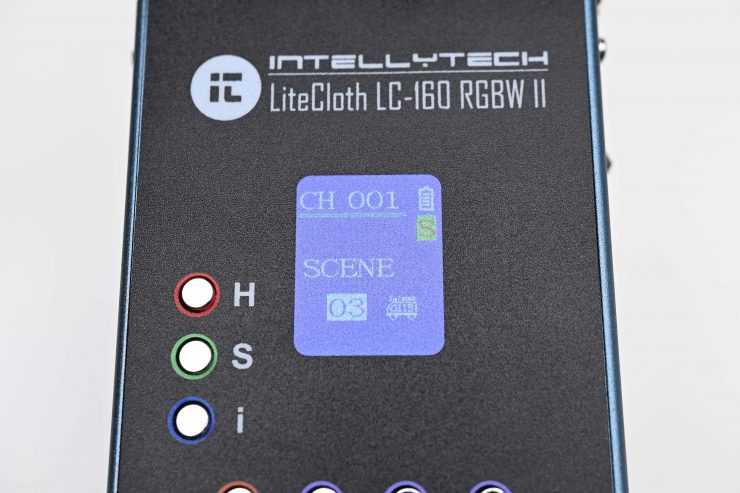
The light has quite a few effects that you can choose from. While I don’t personally use effects that often in my work, it is nice to have them available on tap if you need them, especially in a portable, battery-powered fixture.
Below are the effects that you can choose from:
- Police Lights
- Ambulance
- Fire Truck
- Lightning 1
- Lightning 2
- HSI Demo (Slow)
- HSI Demo (Fast)
- TV Screen
- Candle
- Paparazzi
- Strobe
- High/Low Beam
- Double Flash (Hazard)
- Red Flash
- Green Flash
- Blue Flash
- Party 1
- Party 2
Output & Color Temperature Accuracy
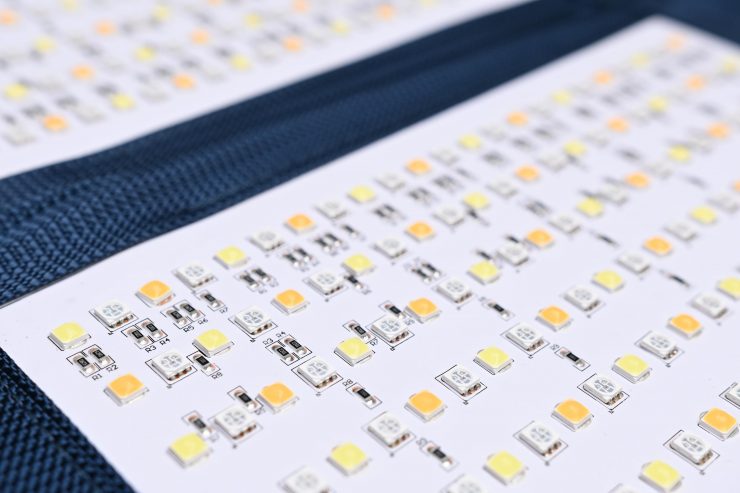
A big factor for a lot of people when buying a light is how much output it can produce. Intellytech claims that the light puts out around 3350 lux @ 3′ when it is set at 5600K. Well, lets put that to the test. I tested the lights output at a variety of Kelvin color temperatures both running on mains and battery power using a Sekonic C-800 at a distance of 1m (3.28ft) in a controlled environment; you can see the results below.
5600K
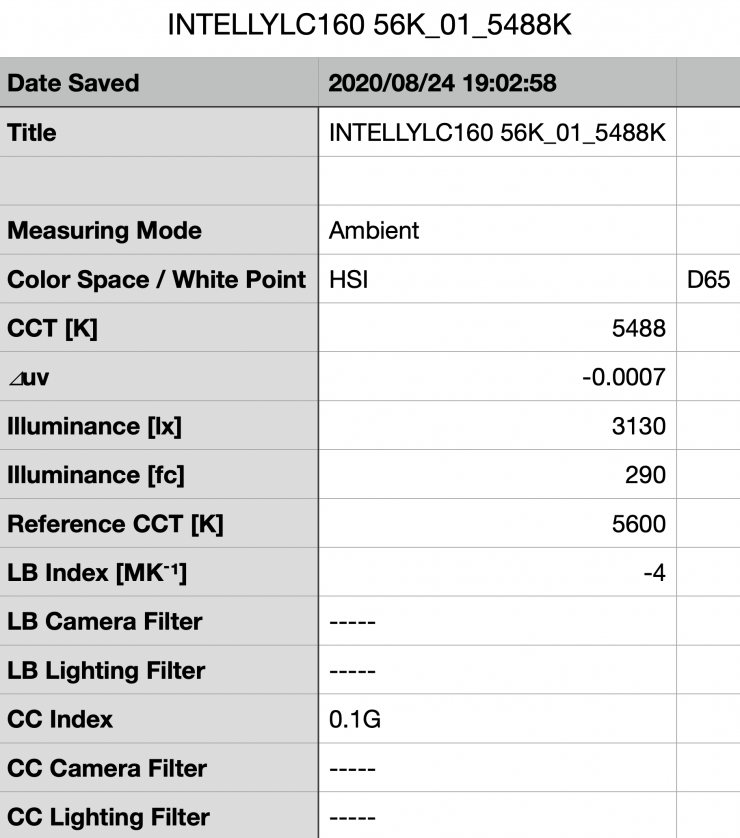
Above you can see the LiteCloth LC-160RGBW II recorded an output of 3130 lx / 290 (fc) when set at 5600K and run off mains power. Intellytech claims the light outputs 3,350 lx / 311 (fc) at 3′ (0.91m). So, based on my recorded results, that figure seems correct.
3130 lx is hardly an earth-shattering figure in 2020 and you will find there are quite a few 1×1 RGBW lights that will give you a far greater output. However, you need to remember that the Intellytech is outputting that 3130 lx over a far wider surface area than a 1×1 panel light.
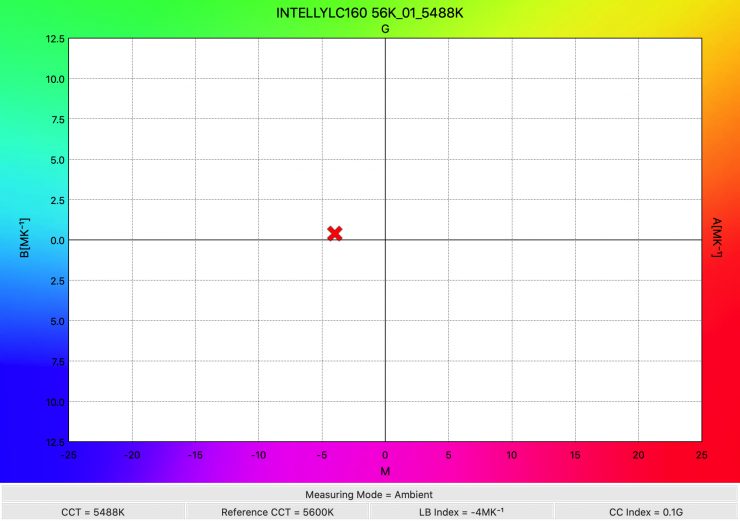
The LiteCloth LC-160RGBW II produced a Kelvin color temperature of 5488K, which was not bad, but it could have been a little better. The light also had a CC Index score of 0.1G.
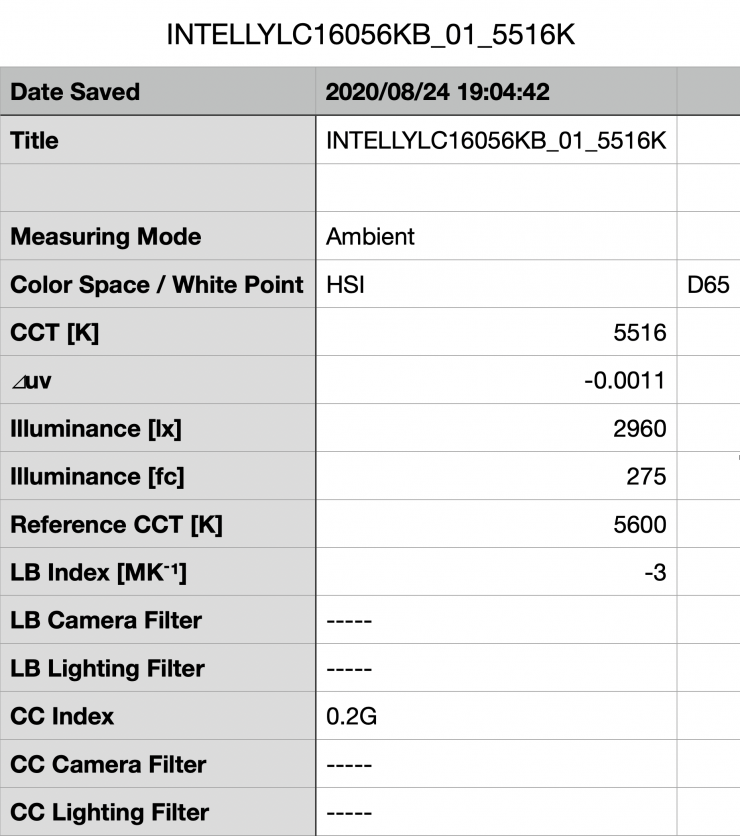
I also tested how much output the light had when being run off a v-lock battery. Usually, lights have less output when being run off batteries as opposed to mains power. The LiteCloth LC-160RGBW II had an output of 2960 lx (275 fc) at 5600K. That was 5.4% less than when it was run off mains power. This is a marginal loss and one most users would probably struggle to see.
50% Output
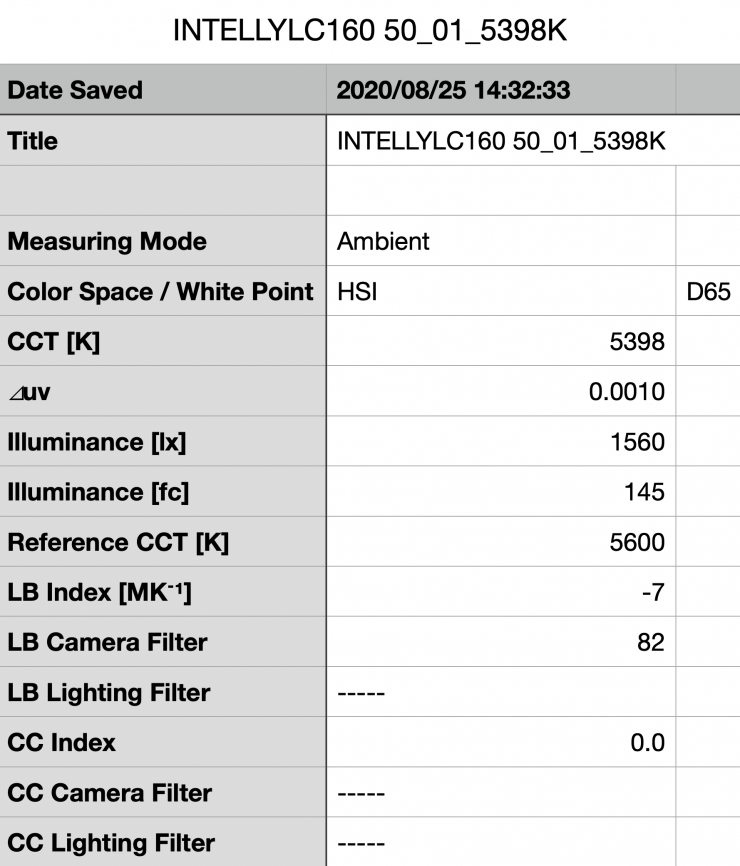
Above you can see the results from when I set the light at 50% output. I did this to see just how linear the dimming curve is for the light. At 50% output it produced 1560 lx (145 fc). This was 50.1% of the output it has when used at 100%. This showed me that the light does appear to have a very linear dimming curve. However, the Kelvin color temperature was 90K lower than when used at 100%. This tells me that the light is not maintaining the same Kelvin color temperature once you start to dim it.
Diffusion
As the light also comes with diffusion I wanted to do another test to see how much output is being lost when you use it.
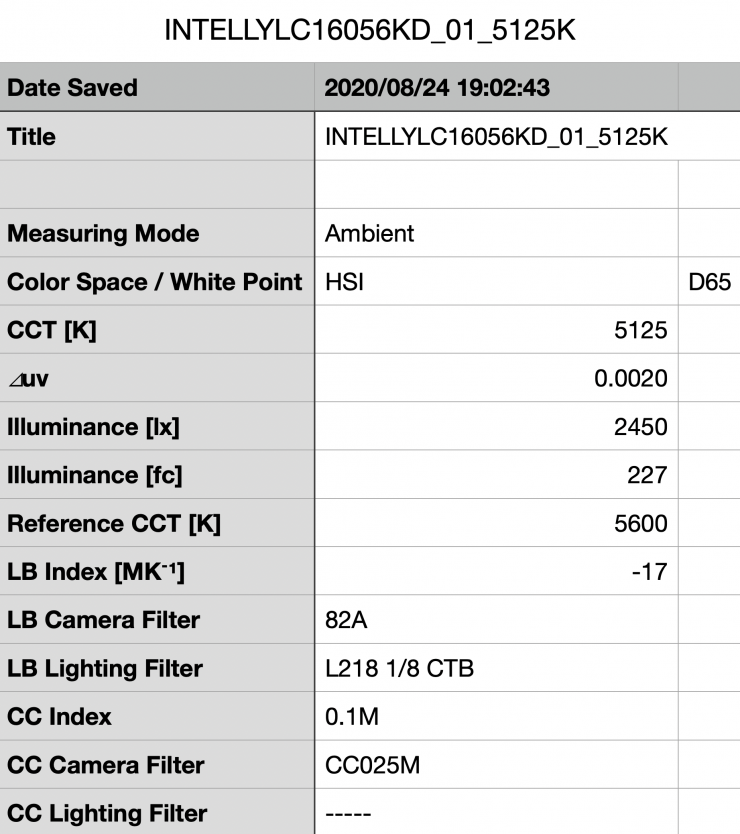
Above you can see that when the light had diffusion attached it recorded an output of 2450 lx (227 fc). This was 21.7% less output than when using the light without the diffusion. This shows me that the diffusion is quite light in strength.
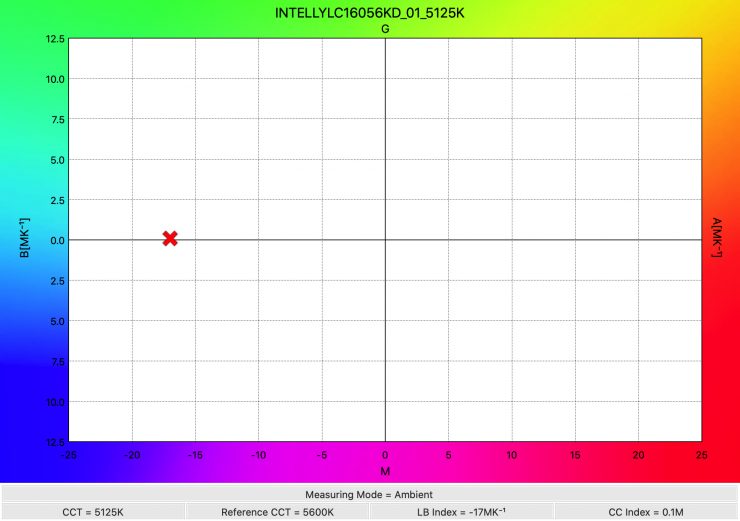
What was also interesting is that the diffusion slightly changed the Kelvin color temperature reading I was getting. With the diffusion, I got a reading of 5125K which was quite a bit lower than when the light is used without the diffusion. This is something to keep in mind, because you may want to increase the color temperature slightly on the controller to compensate for this.
3200K
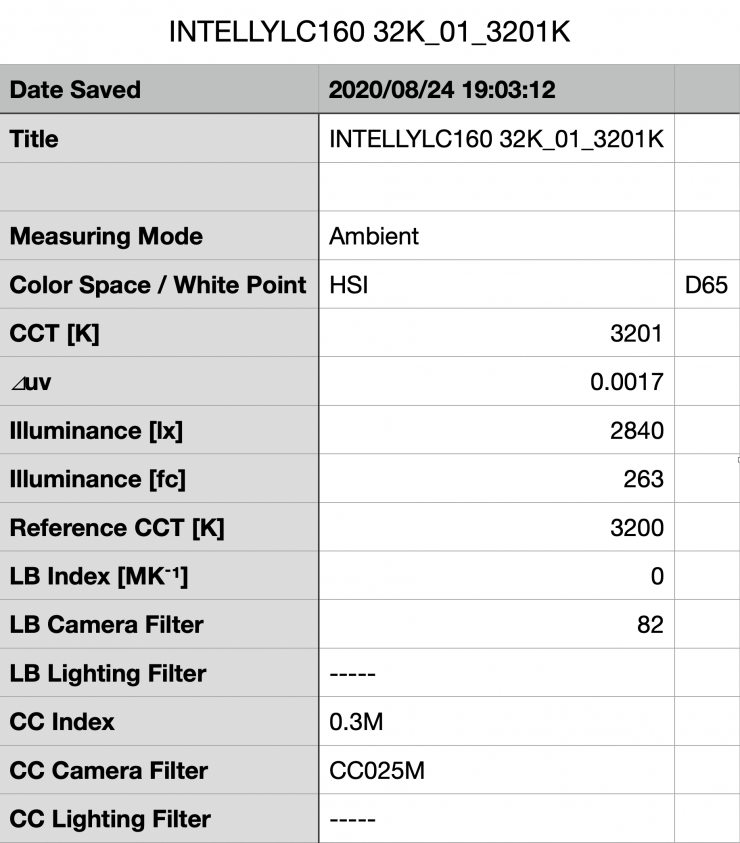
Above you can see the lights output when it was set at 3200K. It produced 2840 lx (263 fc), which is 9.2% less than the 3130 lx it produced at 5600K.
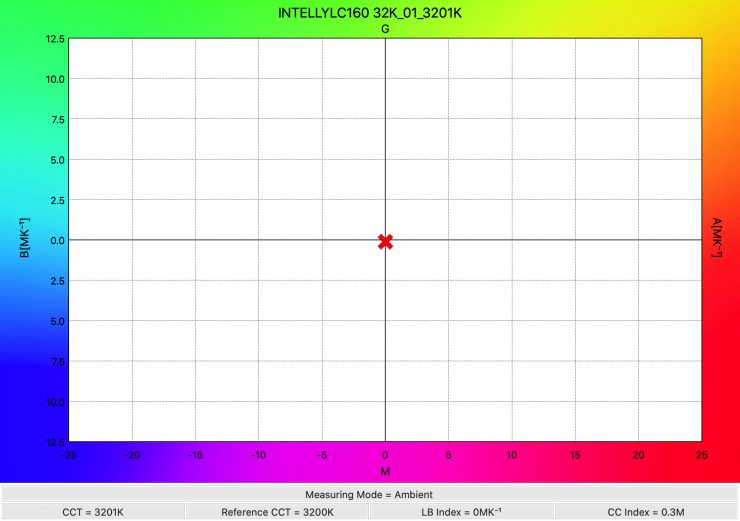
As far as Kelvin color temperature accuracy goes, it recorded an exceptionally accurate reading of 3201K. It showed a slight push towards magenta (0.3M). The light is a lot more Kelvin color accurate at 3200K than at 5600K.
HSI Output
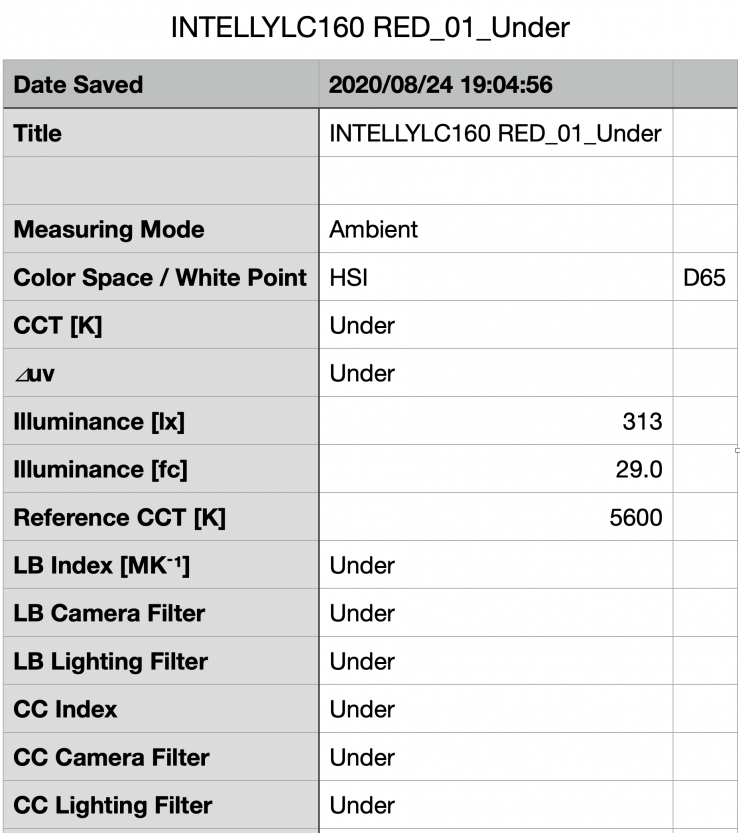
How about output when generating a saturated color? With all RGBW lights, you are going to lose a ton of output once you use them in an HSI mode. Above you can see how much the fixture outputs when outputting pure red at 100%. The light was only able to output 313 lx. Essentially you are losing 90% of the output when generating pure saturated colors. This is something you need to be aware of if you plan on using RGBW lights.
How does it perform at various Kelvin color temperatures?
Summary of results
| OUTPUT | KELVIN COLOR TEMPERATURE | |
| 3000K | 2770 lx | 3030K |
| 3200K | 2840 lx | 3201K |
| 4500K | 2970 lx | 4452K |
| 5600K | 3130 lx | 5488K |
| 6500K | 3150 lx | 6391K |
| 8000K | 3270 lx | 7819K |
| 9999K | 3070 lx | 11156K |
The light has a reasonably consistent output across its Kelvin color temperature range.
The results also show me that the light is accurate when it comes to Kelvin color temperature reproduction at 4500K and below. Above 4500K it isn’t as accurate, but in saying that, the results are still fairly good.
CC Index & ⊿uv
The CC Index displays the CC correction value and whether any magenta or green need to be added or subtracted. 1 CC corresponds to 035 Kodak CC values or 1/8 Rosco filter values. Any reading less than +1.00 or -1.00 and you’re probably not going to need to make any kind of adjustment. The ⊿uv is the value to show how much this light is away from being an ideal light source (black body radiation = incandescent lamp). As with the CC Index you want this number to theoretically be zero. Kelvin is not a linear value, so we need to convert from Kelvin to MK-1 to compare the values of color temperature. To calculate from Kelvin to Mired is MK-1= 1*1000000/Kelvin. While this may sound confusing, it is the only way of measuring if the Kelvin shift is significant enough to warrant having to use a filter for correction. Below are the results for the LiteCloth LC-160RGBW II:
Kelvin Vs MK-1
| Kelvin | Difference in K | MK-1 | Difference in MK-1 | |
| SET VALUE | 3000K | 0 | 333.33 | 0 |
| ACTUAL READING | 3030K | 30 | 330.03 | 3.3 MK-1 |
| SET VALUE | 3200K | 0 | 312.5 | 0 |
| ACTUAL READING | 3201K | 1 | 312.4 | 0.1 MK-1 |
| SET VALUE | 4500K | 0 | 222.22 | 0 |
| ACTUAL READING | 4452K | 48 | 224.6 | -2.38 MK-1 |
| SET VALUE | 5600K | 0 | 178.57 | 0 |
| ACTUAL READING | 5488K | 112 | 182.21 | -3.164 MK-1 |
| SET VALUE | 6500K | 0 | 136.93 | 0 |
| ACTUAL READING | 6391K | 109 | 156.47 | -19.54 MK-1 |
| SET VALUE | 8000K | 0 | 125 | 0 |
| ACTUAL READING | 7819K | 181 | 127.89 | -2.89 MK-1 |
| SET VALUE | 9999K | 0 | 100.01 | 0 |
| ACTUAL READING | 11156K | 1157 | 89.63 | 10.38 MK-1 |
These figures might look confusing, but what it tells me is that the light is very Kelvin color accurate at most temperatures. Any MK-1 score that is under -9/9 means you wouldn’t have to use any color correction gels. With this light at 6500K and 9999K, you would need to correct the light by either making adjustments to the Kelvin color temperature on the light itself or use color correction gels.
CC INDEX & ⊿uv
| CC INDEX | ⊿uv | |
| 3000K | 0.4M | 0.0030 |
| 3200K | 0.3M | 0.0017 |
| 4500K | 0.1G | -0.0022 |
| 5600K | 0.1G | -0.0007 |
| 6500K | 0.2G | 0.0005 |
| 8000K | 0.2G | 0.0033 |
| 9999K | 0.1G | 0.0088 |
Color Rendering
5600K
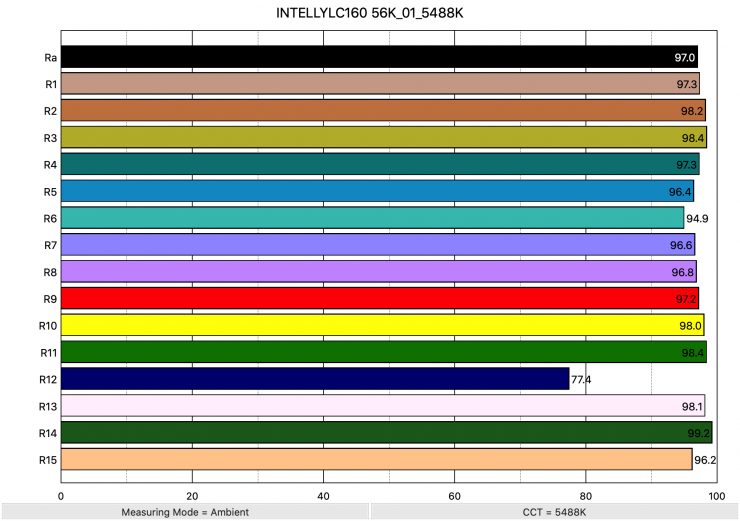
So now that we have seen how much output the LiteCloth LC-160RGBW II produces, how does it perform when it comes to replicating accurate colors. Above you can see that when the light was set at 5600K it recorded an average CRI (R1-R8) of 97.0 and an extended CRI (R1-R15) of 96.05. For replicating accurate skin tones it recorded for 97.2 R9 (red), 98.1 for R13 (closest to caucasian skin tones), and 96.2 for R15 (closest to Asian skin tones). These are very good results.
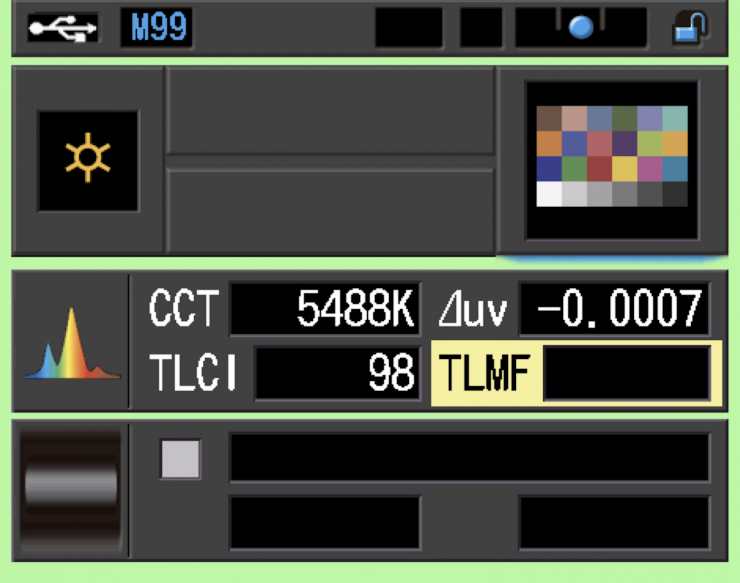
The light when set at 5600K also recorded a TLCI score of 98.
As a comparison, I compared the color rendering of the Intellytech to the Aladdin Bi-Flex2 Bi-Color LED Panel 1×2. The Aladdin has excellent color rendering scores and I personally consider it to be a benchmark for flexible LED panels.
| CRI | EXTENDED CRI | R9 | R13 | R15 | |
| Aladdin Bi-Flex2 Bi-Color LED Panel 1×2 | 98.5 | 97.54 | 96.7 | 98.6 | 98.8 |
| Intellytech LiteCloth LC-160RGBW II | 97.0 | 96.05 | 97.2 | 98.1 | 96.2 |
Above you can see a head-to-head comparison of the Aladdin Bi-Flex2 Bi-Color LED Panel 1×2 and the LiteCloth LC-160RGBW II when used at 5600K. Despite the Intellytech being larger and also RGBW it stands up very well to what I consider to be the industry benchmark.
3200K
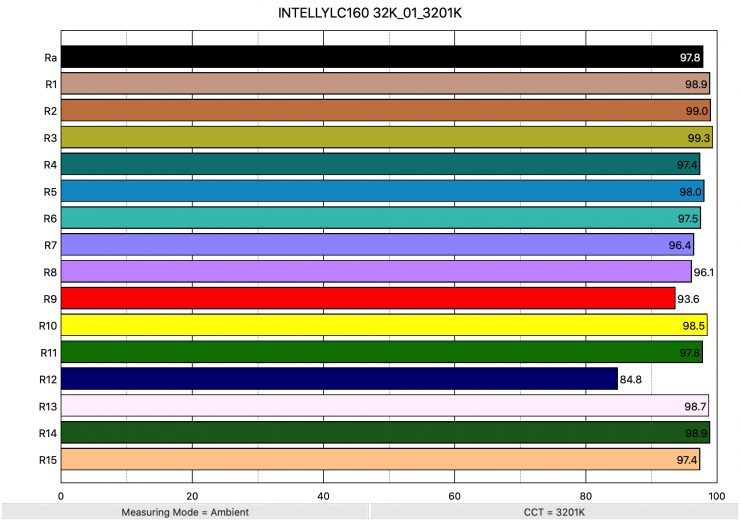
Above you can see the scores for when the light was used at 3200K. It recorded an average CRI (R1-R8) of 97.8 and an extended CRI (R1-R15) of 96.82. For replicating accurate skin tones it recorded 93.6 for R9 (red), 98.7 for R13 (closest to caucasian skin tones), and 97.4 for R15 (closest to Asian skin tones). These are excellent results.
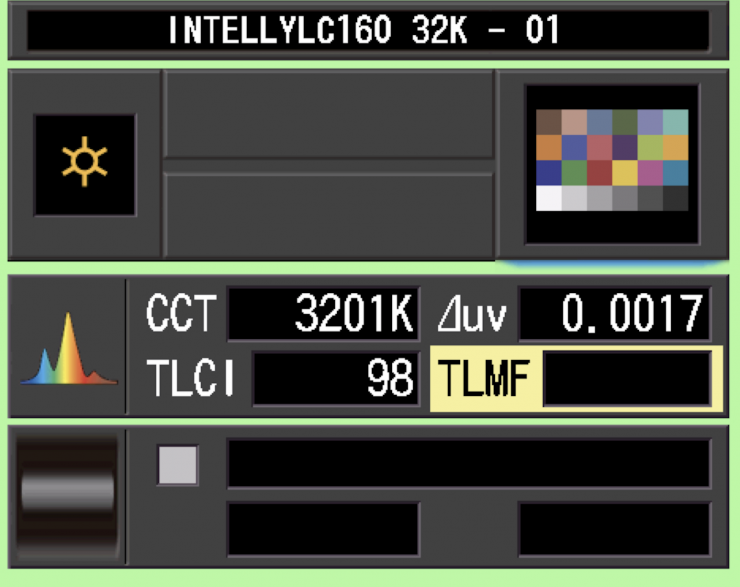
The light, when set at 3200K, recorded a TLCI score of 98.
| CRI | EXTENDED CRI | R9 | R13 | R15 | |
| Aladdin Bi-Flex2 Bi-Color LED Panel 1×2 | 98.5 | 97.54 | 96.7 | 98.6 | 98.8 |
| Intellytech LiteCloth LC-160RGBW II | 97.8 | 96.82 | 93.6 | 98.7 | 97.4 |
Above you can see a head-to-head comparison of the Aladdin Bi-Flex2 Bi-Color LED Panel 1×2 and the Intellytech when used at 3200K. Again, just like at 5600K the Intellytech stands head-to-head with the Aladdin.
SSI
SSI (Spectral Similarity Index) was developed by the Sci-Tech Council of the Academy. SSI gives me the ability to set any light as a standard, or use predefined standards (such as CIE D55), and then give other lights an SSI score based upon how well they will match standards such as CIE D55 measure spectral response and compare it directly against an ideal light source.
SSI is a much better way to judge an LED light than CRI or TLCI.
SSI is useful to see how well different lights will play together. As the Sekonic C-800 Spectromaster can measure SSI, I decided to test out the Intellytech to see how it performed.
3200K
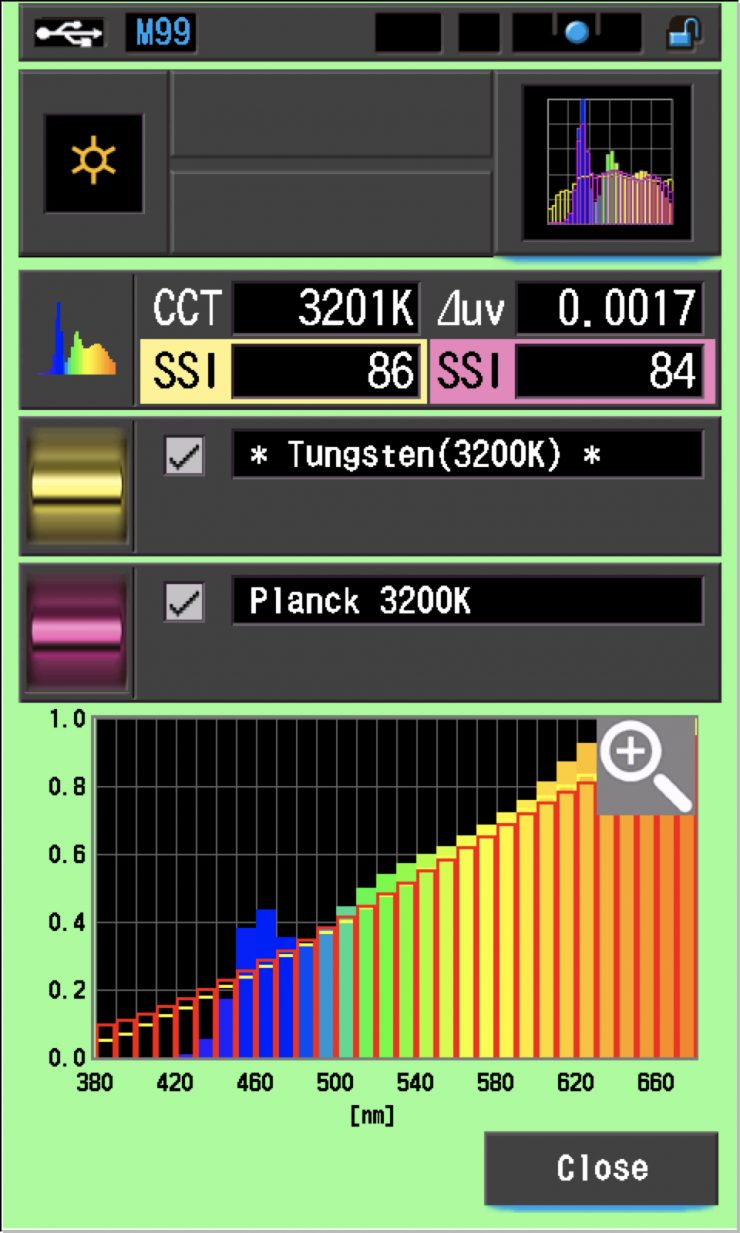
Above are the scores for the light when used at 3200K. The scores show that the light does a very good job of accurately replicating a 3200K (Tungsten) source. Any score in the mid to high 80’s is outstanding for an LED light.
5600K
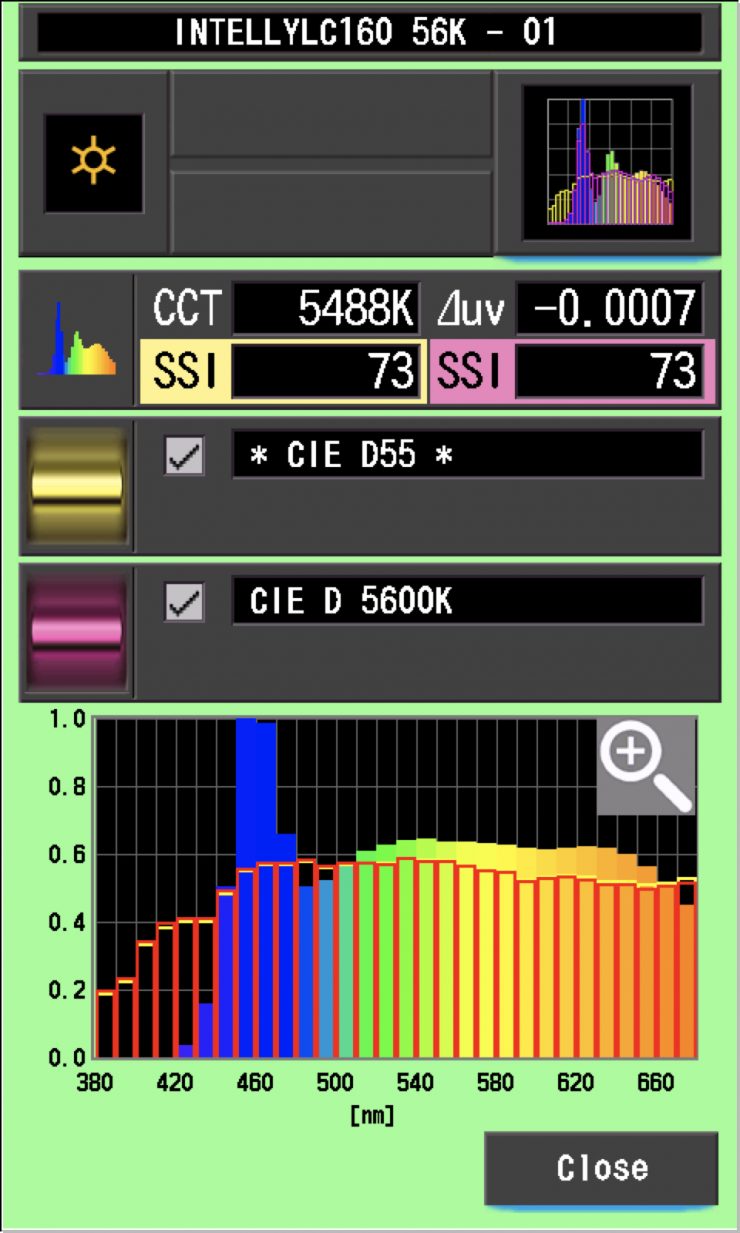
Above are the scores for the light when used at 5600K. The scores show that the light does a very good job of accurately replicating a CIE D55 source. A score in the low to mid-70s is very typical for a 5600K LED light.
The main reason we want to record SSI scores is so we can see how well they match with other lights. I was curious to see how well the Intellytech LiteCloth LC-160RGBW II matched the larger MEGA-LiteCloth at both 3200K and 5600K. As they are both made by the same company, you would expect them to play well together. Below you can see the results.
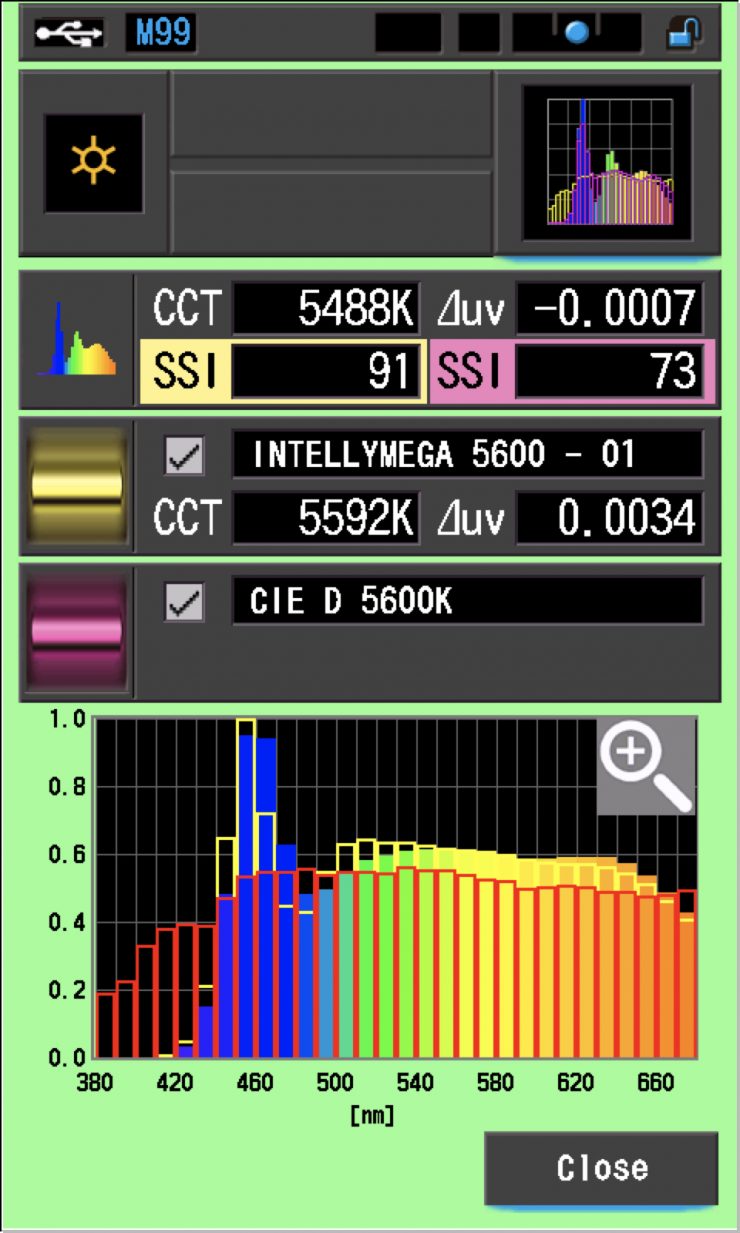
As you can see the Intellytech LiteCloth LC-160RGBW II and the MEGA-LiteCloth are not a perfect match when used at 5600K. A score of 91 is still pretty good, but you would need to adjust both lights slightly to get them to the point where they were a closer match.
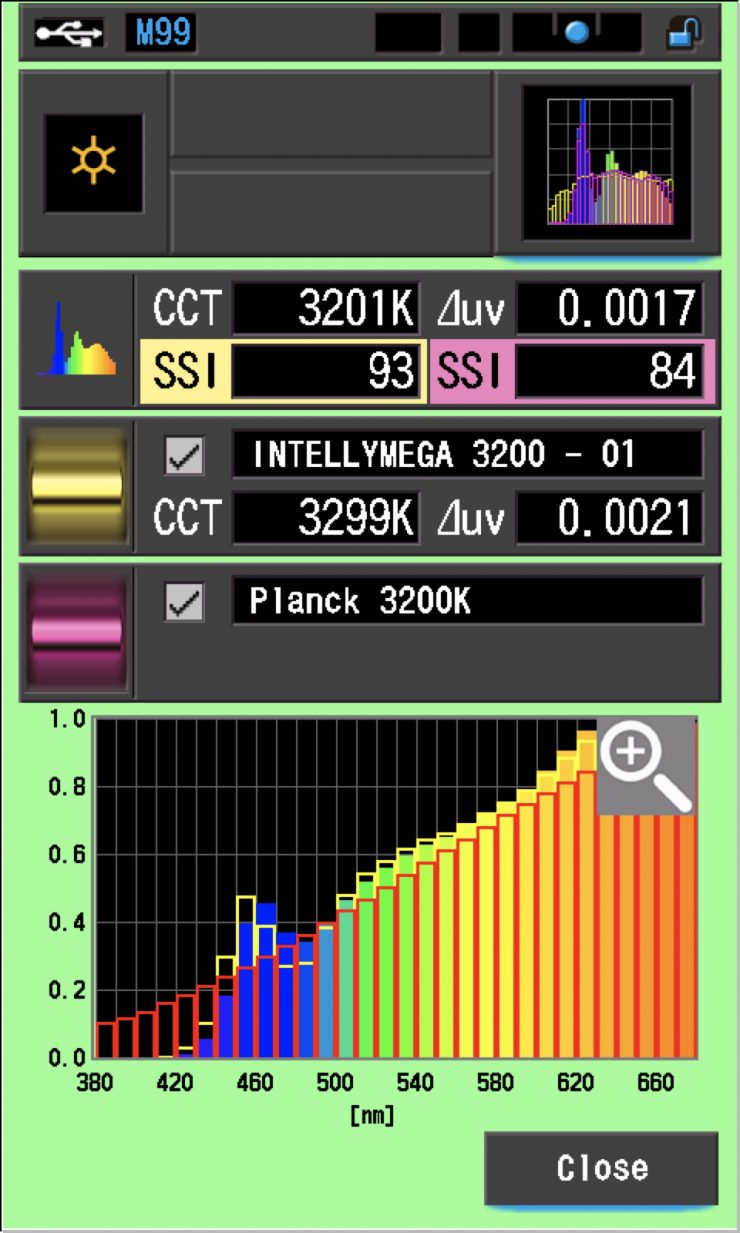
At 3200K the Intellytech LiteCloth LC-160RGBW II and the MEGA-LiteCloth are a slightly better match than they are at 5600K.
Being able to measure SSI in advance and compare different lights you may be using together is a great way of finding out what lights will work together and what adjustments need to be made.
Spectral Distribution
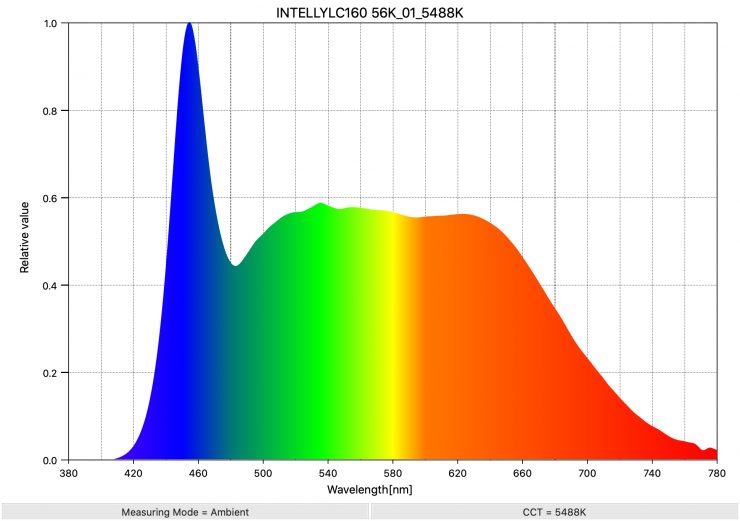
Above you can see the spectral distribution of the LiteCloth LC-160RGBW II when it is set at 5600K. The spectral distribution is nice and full and there aren’t any spikes.
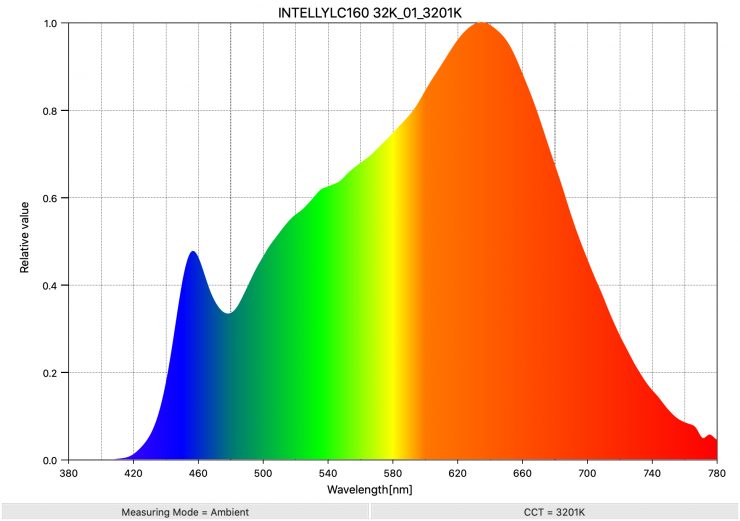
Above you can see the spectral distribution of the light when it is set at 3200K. The spectral distribution is nice and full and the light only has the slightest bump in green.
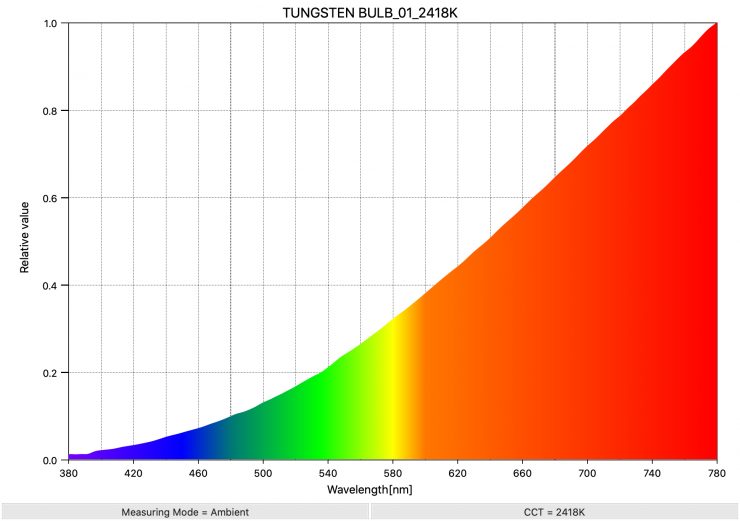
As a comparison, above you can see what the spectral response of a tungsten light bulb looks like.
Real-World Performance and Quality of Light
As I always say, photometric scores only tell you part of the story. So do the scores from the Intellytech LiteCloth LC-160RGBW II translate into real-world performance? The fixture produces a nice quality of light, especially when used with the included softbox.
It isn’t overly bright for a fixture of this size, and you do need to take that into account. Having 3130 lx (without diffusion) is going to mean that this light will only be suitable for certain applications. As a key light or a fill light it will work well as long as you aren’t trying to match a bright background.
In a pinch, because the light is a flexible panel, you could also bend it in half and have one side of the light facing one direction and the other side of the light facing the opposite direction. This makes for a very quick and easy solution if you need to light the interviewer and the interviewee with a limited amount of lights.
Despite its relatively modest output, the wide beam angle certainly helps to spread that light out over a wide area. In a lot of ways, this makes it more useful than a traditional 1×1 panel as it allows you to create a larger, softer light source that isn’t possible when using a lot of 1×1 panels.
I like that I can use the lights via mains power or through a flight safe V-lock camera battery. This makes it very suitable for traveling shooters.
Having built-in effects and the ability to use the light as an RGBWW fixture is also a nice added touch.
Most of all I like the design of the mounting bracket and the fact that the entire kit fits in a hard case that doesn’t take up too much space.
Who is the light aimed at?
You could use the LC-160RGBW II for lots of different applications, but the light is certainly being targeted as a nice mid-sized portable light source that can be used in any location.
For traveling shooters who work by themselves or in small crews, the light makes a lot of sense as it can easily be powered in the field and because it is a flexible panel light it is easy to mount or position in places where other lights won’t go.
Alternative Solutions
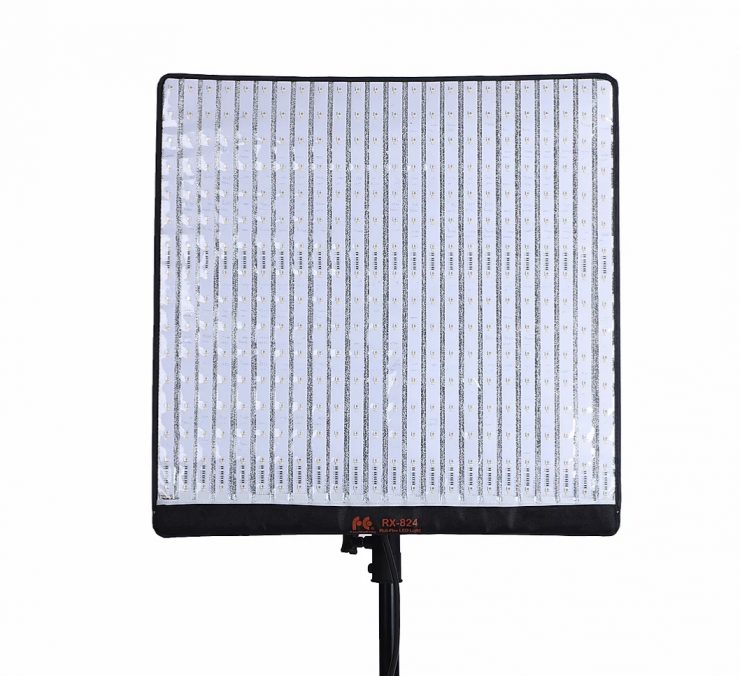
There aren’t many 2×2 sized RGBW flexible panel lights on the market. The only other one I am aware of is the Falconeyes RX-824-K. This draws 150W and retails for $1,006.29 USD
Optional Accessories
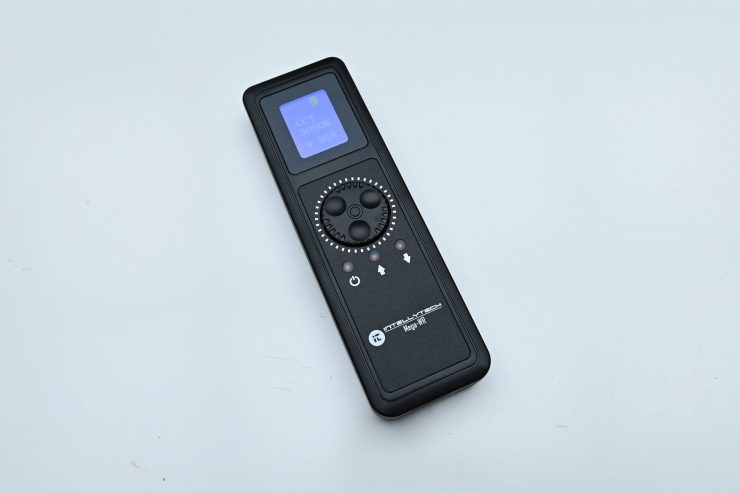
Intellytech offers the LC-WR – Wireless Remote Controller ($59.00 USD) and either a 20′ or 32′ LiteCloth Extension Cable ($27/$39 USD).
The remote controller is fairly simple, but it works well and if you are behind the camera and you want to make an adjustment it makes a lot more sense than walking over to the light and making an adjustment on the controller.
Price
The Intellytech LiteCloth LC-160RGBW II is available in two versions for $1,099 USD. The only difference between the two versions is the choice of either V-Lock or AB Gold Mount battery plates on the controller/power supply.
The LC-160RGBW II is well priced and you certainly get a lot of value for money. If you think of the light as 4 individual 1×1 panels you are essentially only paying around $250 USD for each panel.
Conclusion
The Intellytech Litecloth LED mats have somewhat changed my mind about flexible LED panel lights. While I have always liked the versatility and color accuracy of flexible LED panels they were traditionally messy to set up and construct. To me, that somewhat defeated the purpose of having a lightweight portable lighting solution.
The LC-160RGBW II is far from perfect when it comes to setting it up and putting it together, however, it is a little easier to set up compared to some of the other flexible panel lights. It is color accurate, has a reasonable amount of output, and is versatile enough to be used in a variety of lighting situations.
The larger MEGA-LiteCloth 3’x 4.5′ Foldable LED Mat Kit is one of my favorite lighting products of the year and I have used it extensively. It produces a beautiful soft light, it is powerful, reasonably easy, and quick to set up, multi versatile, and it offers good value for money considering what you get.
The LC-160RGBW II isn’t going to be suitable for everyone, but if you like the idea of a portable large source that can be powered off a single flight safe battery then it certainly ticks a lot of boxes.
Like what we do and want to support Newsshooter? Consider becoming a Patreon supporter and help us to continue being the best source of news and reviews for professional tools for the independent filmmaker.

